Construction of the Sakhalin-Kuril communication line. Segero Tour - Cable Car
Let us rejoice, comrades!
10 years ago we were glad that the optical communication lines crossed the Tatar Strait, three years ago we admired the fact that we had finished laying optics on Magadan, and a couple of years ago on Kamchatka.
And then came the turn of the South Kuril Islands.
This fall, optics came to the three Kuril Islands. Iturup, Kunashir and Shikotan.
As usual, I tried how much it was in my power to follow up on this matter and I will tell you that everything has already been laid , tested and officially put into operation a couple of weeks ago .
At the invitation of Rostelecom, I managed to visit a ship that was carrying out cable laying work.
The state, represented by Rostelecom, acted as the customer; as the last time, the company was Huawei.
But the cable laying vessel was already different.
Naturally, in the process of laying the cable, there were some political problems with the neighbors . But it seems like nothing further than the notes of protest did not go. Although the devil knows what the situation will go there. But this is a matter of politics already, we will probably keep silent about it.
Korean Segero 1998 release.

The specification of the vessel on the site .
Who cares about other cable-laying ships - here's a great selection for you to admire .
In 2017, the same team that built the line to Magadan and Kamchatka conducted reconnaissance work in the Sea of Okhotsk on our hydrographic vessels, and in 2018 in May, the ship arrived in Vladivostok, took the team and technical specialists and went to the work area for direct installation.
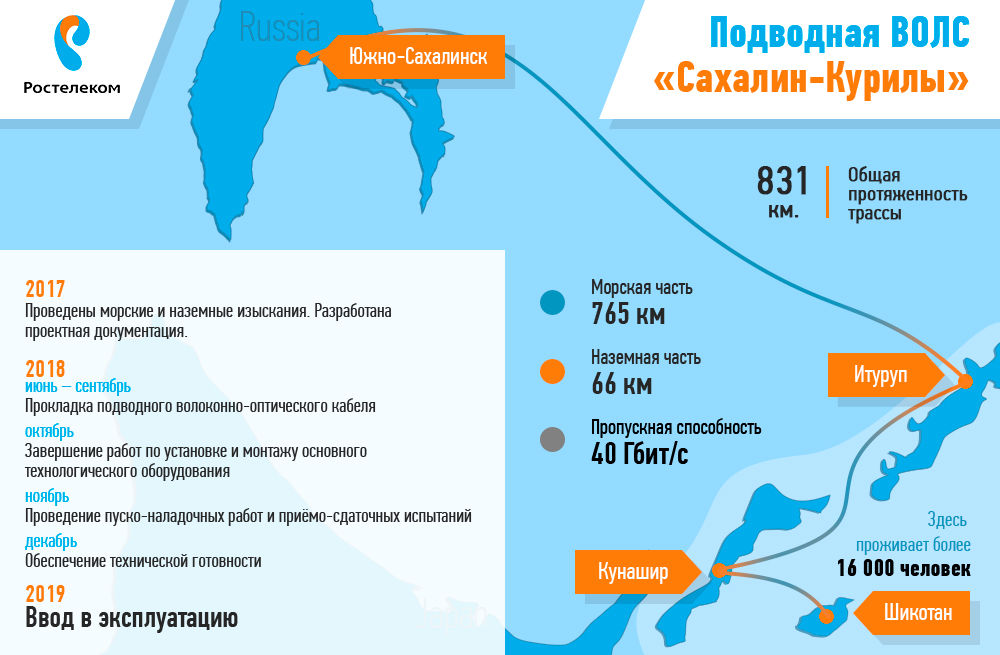
You had a unique opportunity to walk along the ship with the cable layer and see what and how.
Alas, no one else will tell you this, as last time, in a story about another Cable Layer .
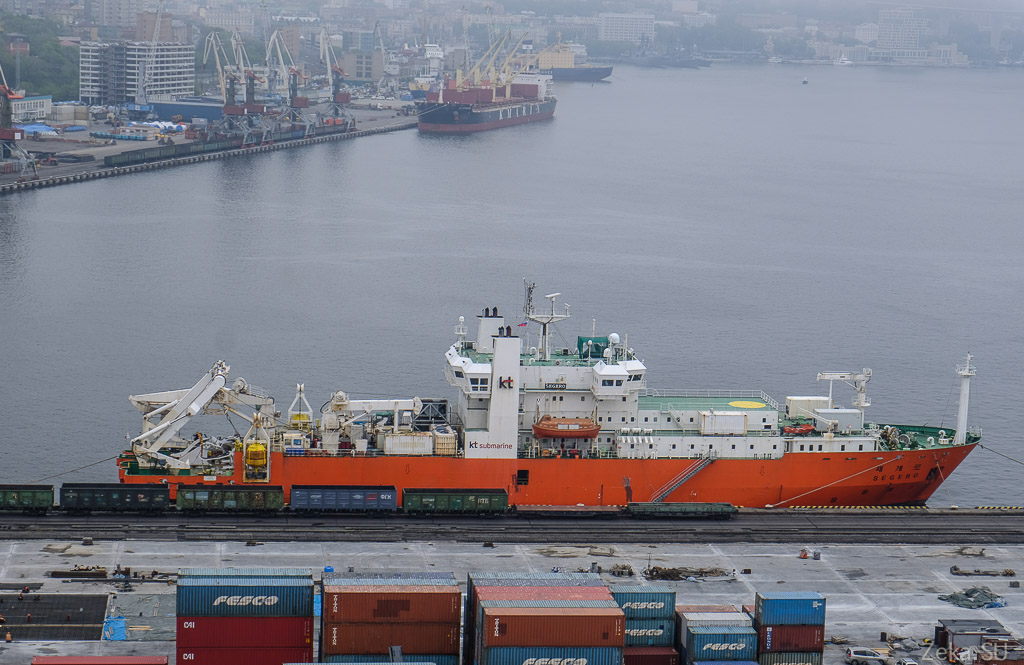
++++++++++++++++++++++++++++++++++++++++++++++++++++ ++++++++++++++++++++++++++++++++++++++
If you do not know or have forgotten how to lay underwater communication lines, I’ll remind you the stages of laying underwater communication lines:
At this stage, the bottom of the sea is examined, or ready-made materials from previous studies are taken. Depending on the topography of the bottom, a route is laid. Naturally, current communications at the bottom are also taken into account. But the benefit is that the Sea of Okhotsk is not rich in underwater pipelines and underwater optical highways, except perhaps secret Pacific Fleet communications cables to which enemy submarines listen .
A hydrographic vessel sets off to the site of work and studies of the day, topography, and determination of cable exit points to the surface on the shore are performed.
The cable is made immediately with a single coil so that under ideal conditions it can be laid from beginning to end, and loaded onto the ship. At the production stage, EDFA (Erbium Doped Fiber Amplifier), a fiber-optic amplifier based on erbium-doped optical fiber, is immediately integrated into the cable.
Due to the fact that Russia does not have such civilian ships, the manufacture of the cable and its laying were assigned to Huawei.
Huawei has no fleet and for this reason hired a subcontractor, kt submarine, a Korean company specializing in underwater operations.
Everything is simple here. At the bottom, from the ship, lower the plow and turn the small forward. He digs a trench, a cable is buried in it.

The only difference with the picture is that under the ship the depth is a couple of kilometers.
Here's another informative video:
If everything went well and the cable reached from coast to coast, then it is connected to the coast station. To do this, thoroughly bury the cable at the connection point in the bottom so that it is not washed by the sea, heap with stones. Connect the earth's end with the sea.
This is how it looks close:
After the work is completed, the wires are stuck, losses are measured, communication is started. If everything works, consumers are connected. Usually they start at a minimum speed, but in the cable usually there are additional wires, through which later, when replacing equipment, you can start large amounts of traffic transfer. Well, again, the reserve, suddenly that will break.
In the description of the process, all kinds of approvals of money and work are omitted, but in our case this is no longer very important.
++++++++++++++++++++++++++++++++++++++++++++++++++++ ++++++++++++++++++++++++++++++++++++++++++
1 And now, we will step aboard the Segero ship and walk a bit.

2 The first thing that we have to do is ... yes that's right, we will put on protective equipment so as not to hit our head where it is not necessary.

3 Last time I didn’t think about how cables were loaded onto a ship. It turns out there are special “filling necks”. I honestly thought just through the open door on board.

The main distinguishing modules of the cable-laying vessel are
The rest is the same as other ships, engine, cabins, galley, dining room. But only, for convenience, on such ships there are a bunch of different thrusters and automatic equipment for millimeter accuracy in keeping the ship in place.
Let's go in order.
4. These mechanisms are conveyors for transferring cable from the tanks to the stern
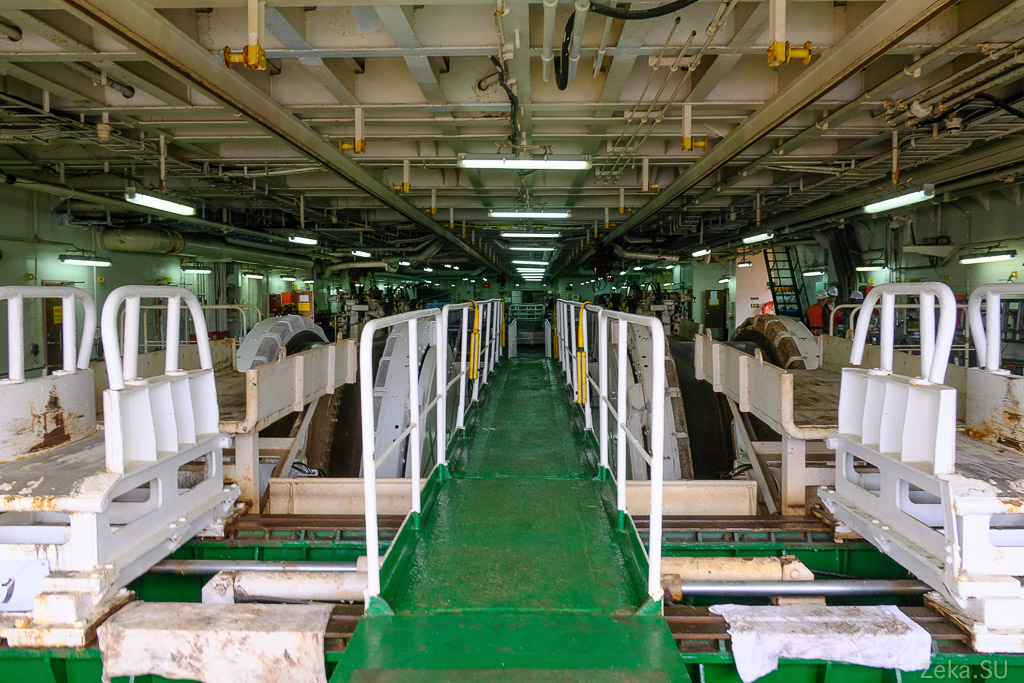
5. Rollers for pulling the cable

6.
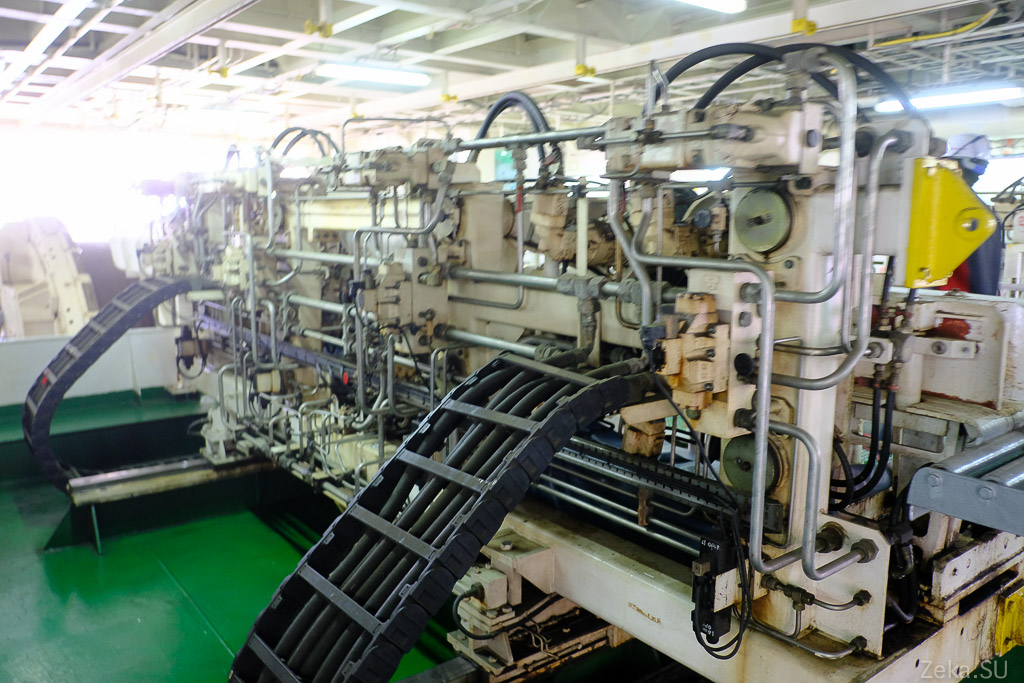
7. At the same time, two cables from 2 tanks can be fed simultaneously

8.

9. I don’t know what to call, but the type of cable channels. Cable
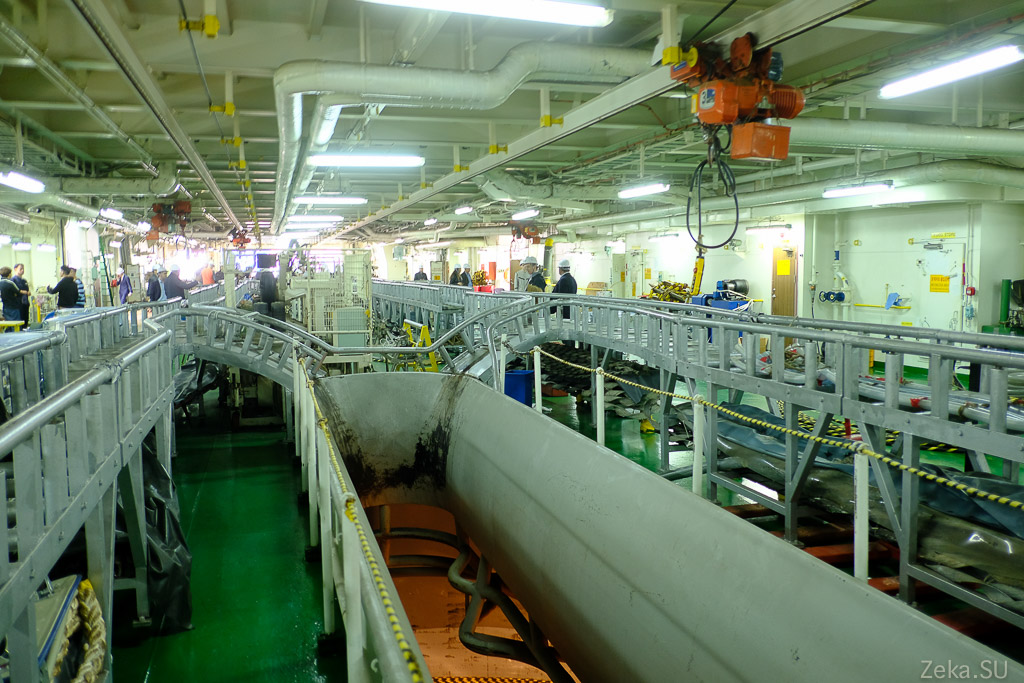
10 runs along them . Signal amplifiers
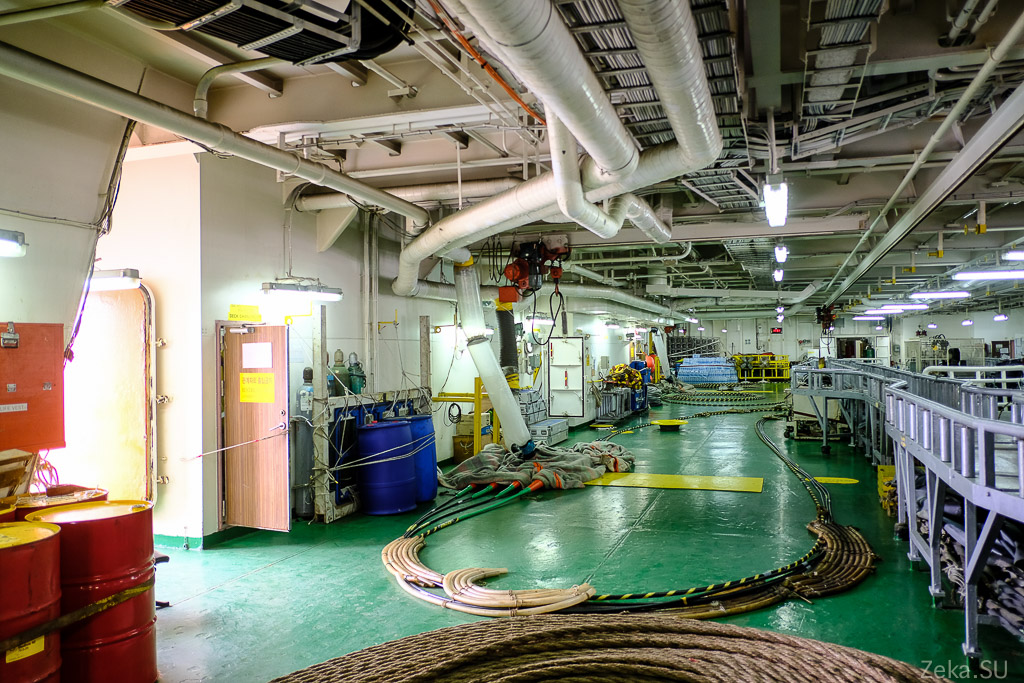
11 are stored on the deck itself . Alas, apparently there is no wet camera on board. The storage scheme was implemented using the “Wet Rag” methodology
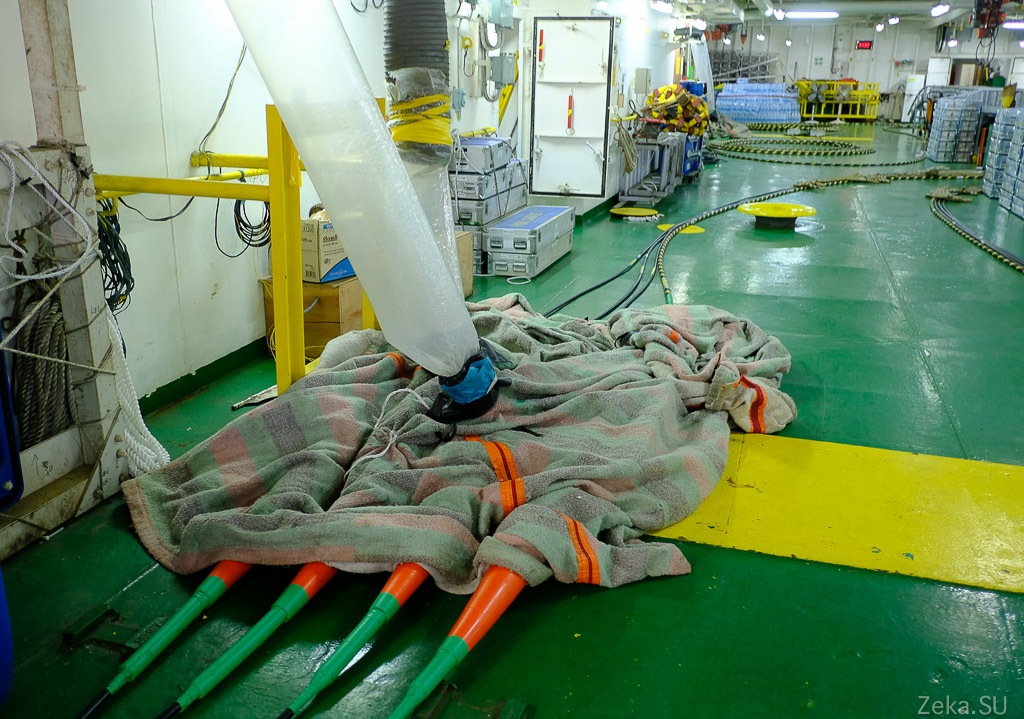
12.
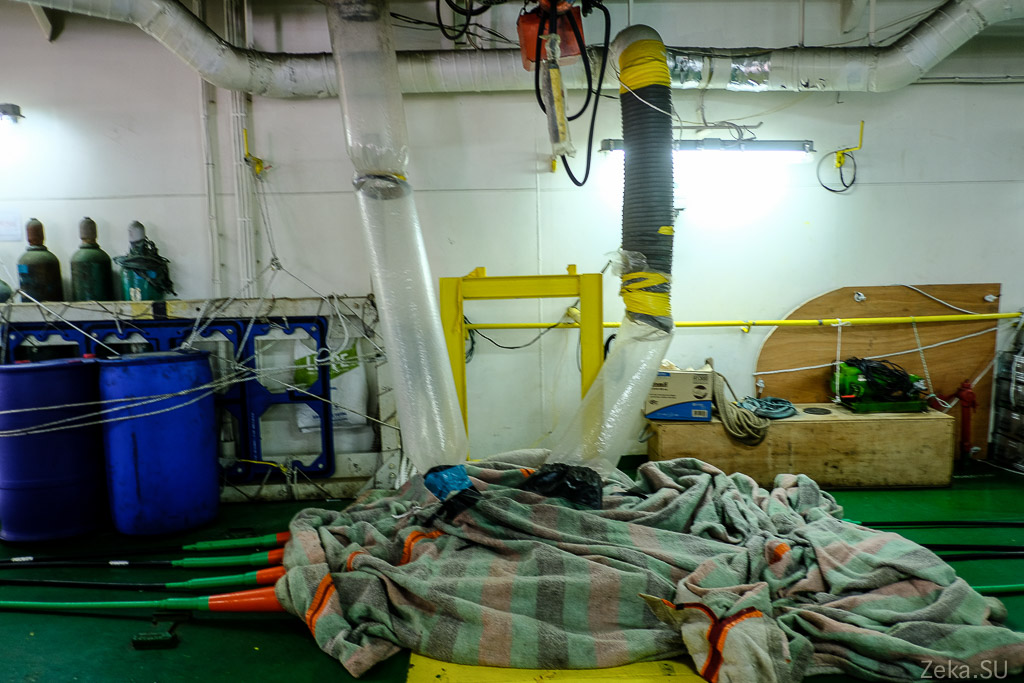
This is a direct disappointment compared to the other cable layer that I was able to visit. You yourself can go and compare http://zeka.su/2016/07/11/3406/
How signal
amplifiers work Amplifiers are most often made on the basis of doping the fiber with rare-earth element erbium.
An additional laser pump beam of high power, but different from the frequency of the laser transmitting the information, is introduced into the fiber and causes the erbium atoms in the amplifier to go into an excited unstable state. When a laser photon weakened by a long fiber-optic path with useful information collides with this atom, it receives energy from this excited atom, and is re-emitted with a new force and flies further, more precisely, it is re-emitted in the form of 2 quanta and useful photons becomes larger.
If all this is explained on the fingers, it will be so.
Tennis balls on which information is recorded are thrown into the pipe and they fly through the pipe from point A to point B. The pipe is long, and when they experience air resistance, they slow down and may not reach the end of the pipe.
But nearby, air is pumped at a high speed along a parallel pipe, and it makes the blades of a wheel type spin like a water mill, or a wheeled steamer, located somewhere in the middle of the pipe.
Having reached this wheel, tennis balls get this wheel on the ass, like a tennis racket and with renewed vigor fly on ... another 80km =)
Who cares, read the normal and useful article on this subject , well, or Wikipedia .
sorry for the confusion, but I'm not very strong in these matters.
But in more detail it is possible to read on Habré in kamenty
13. Also on this deck storage of the additional equipment for laying is carried out. Couplings, adapters and so on. In short, a bunch of any consumables

14. Here you can go to sea =)

15. Here are the suspicious boxes that interest me
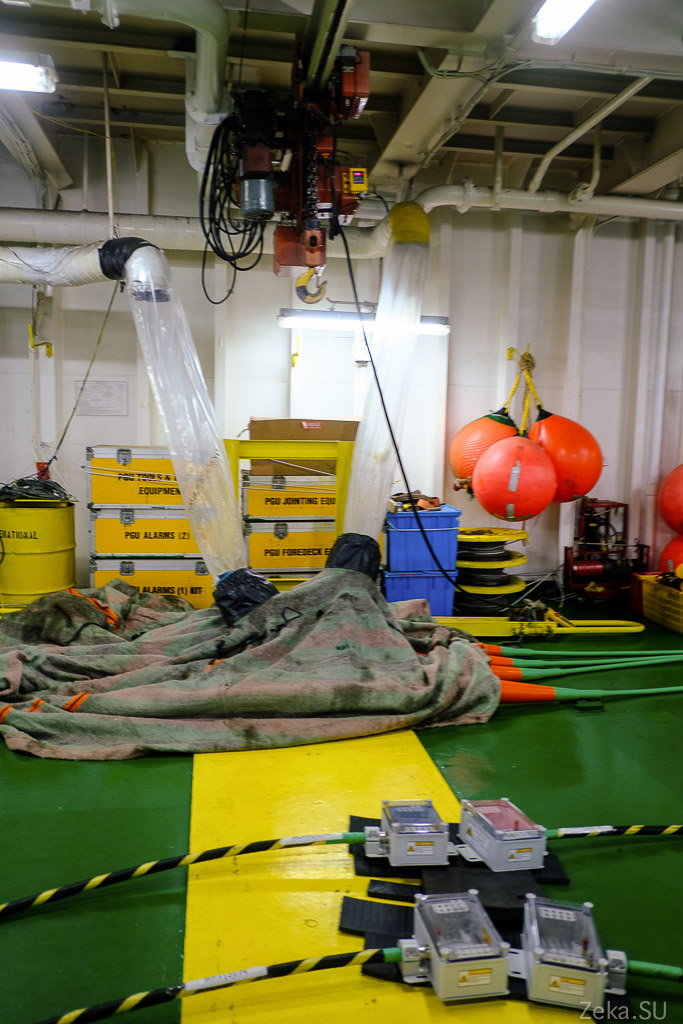
16. This is just an optical coupler for installation in a shore wiring closet. This is the very end of the cable. The terminal equipment will already be connected to it. In the coupling it is just visible that 4 veins are divorced.
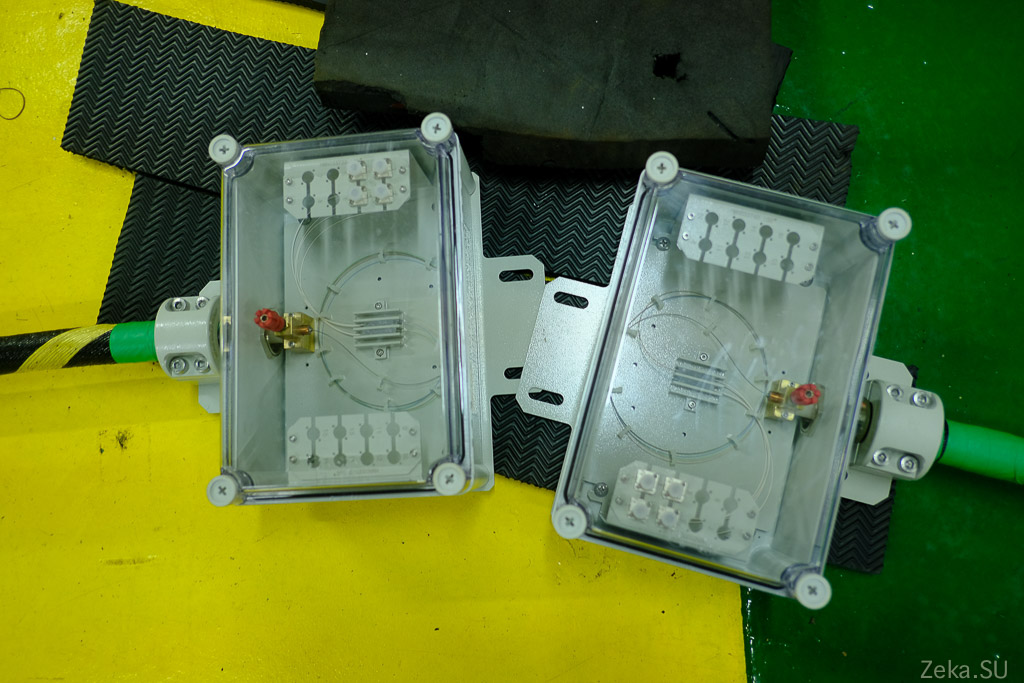
17. Alas, I don’t know what it is, but also probably spare parts and other parts
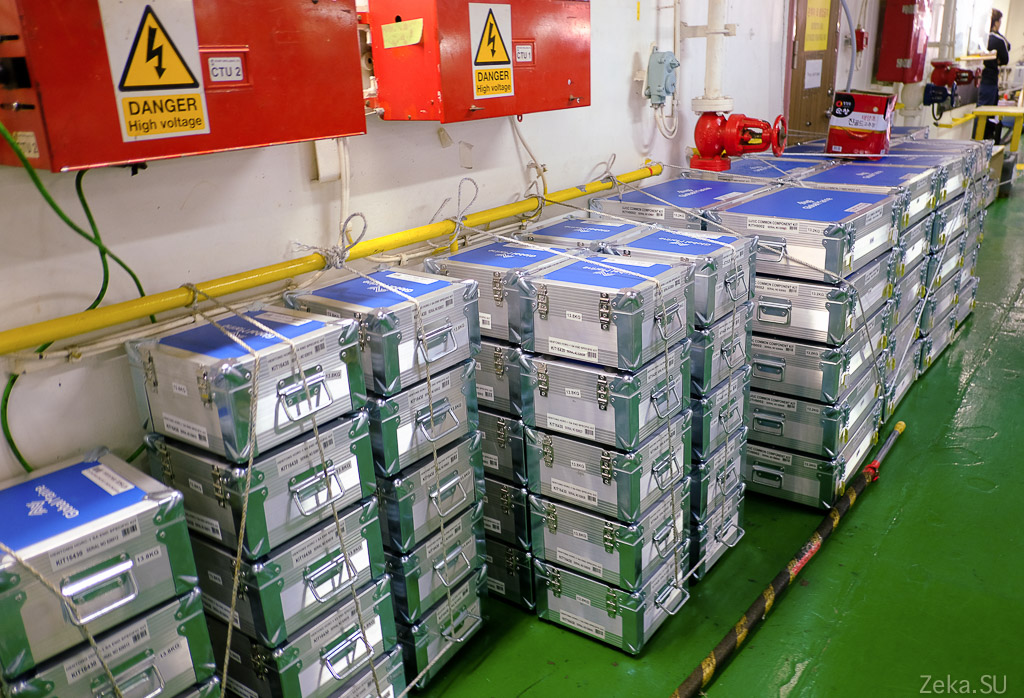
18. Visual aid for laying
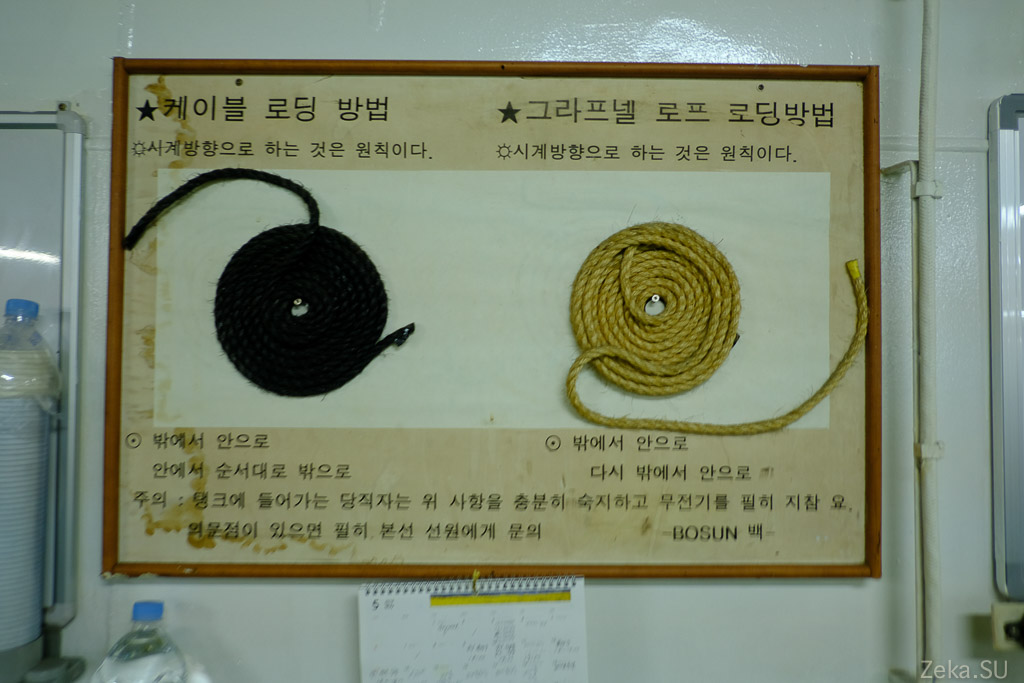
On the cable deck there are naturally two cable tanks - storage.
19. They contain 850 km of cable + reserve.
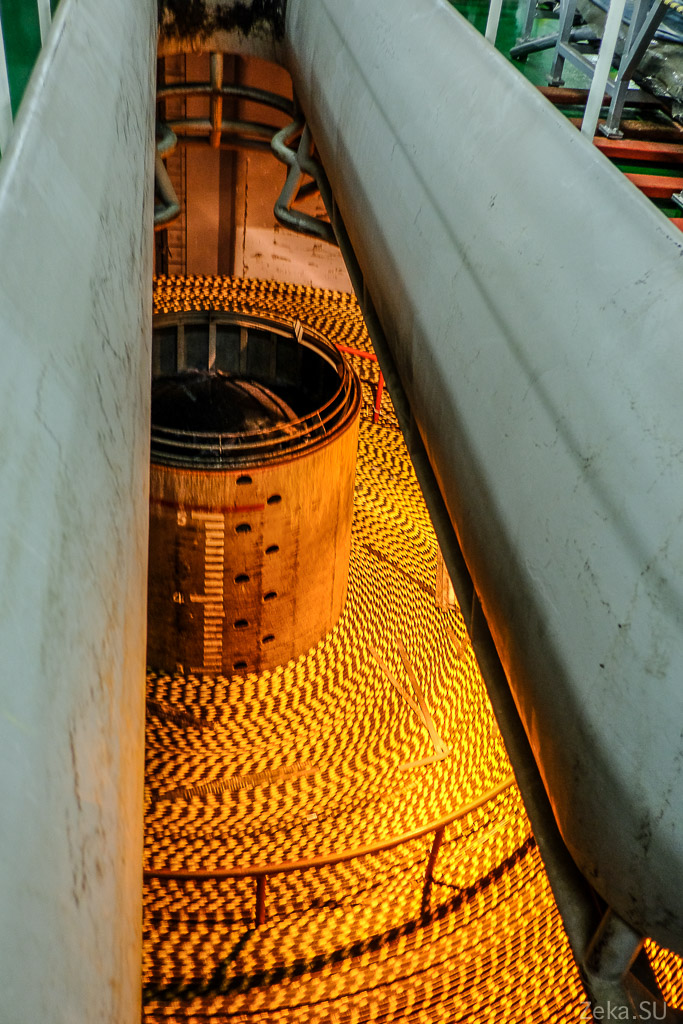
20. Second vault
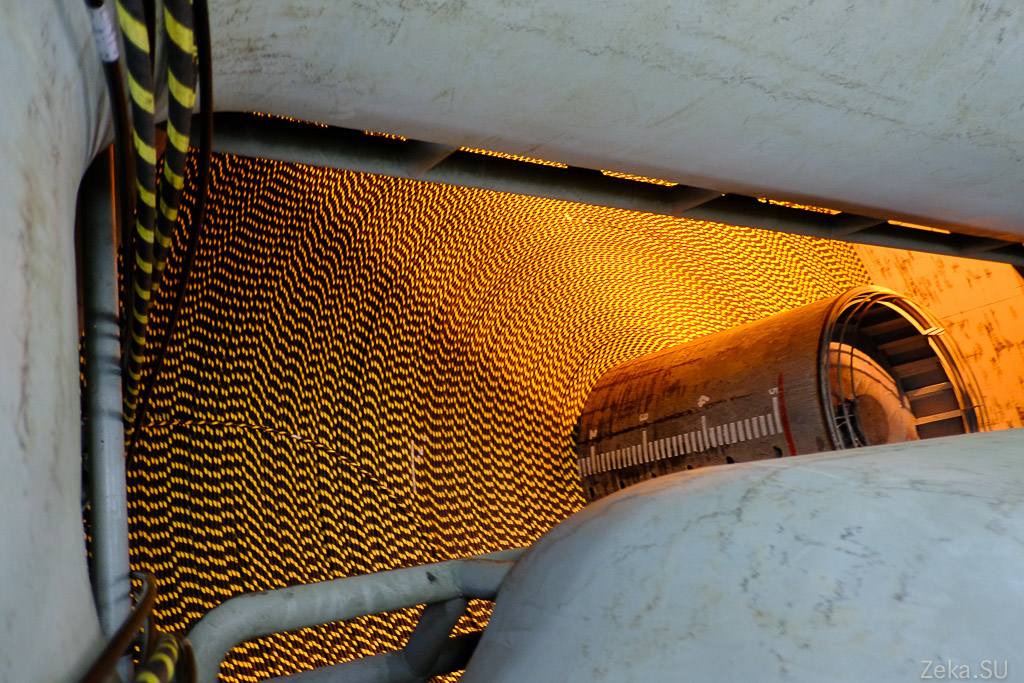
21. Tank walls are rounded so that the cable slides and does not fray

Now let's look into the "clean room." There, work is done on cutting the cable, welding optics and installing couplings, amplifiers and so on.
22. Workbench. Pay attention to homemade bobbins for materials

Tools and a bunch of all kinds of electrical tape.
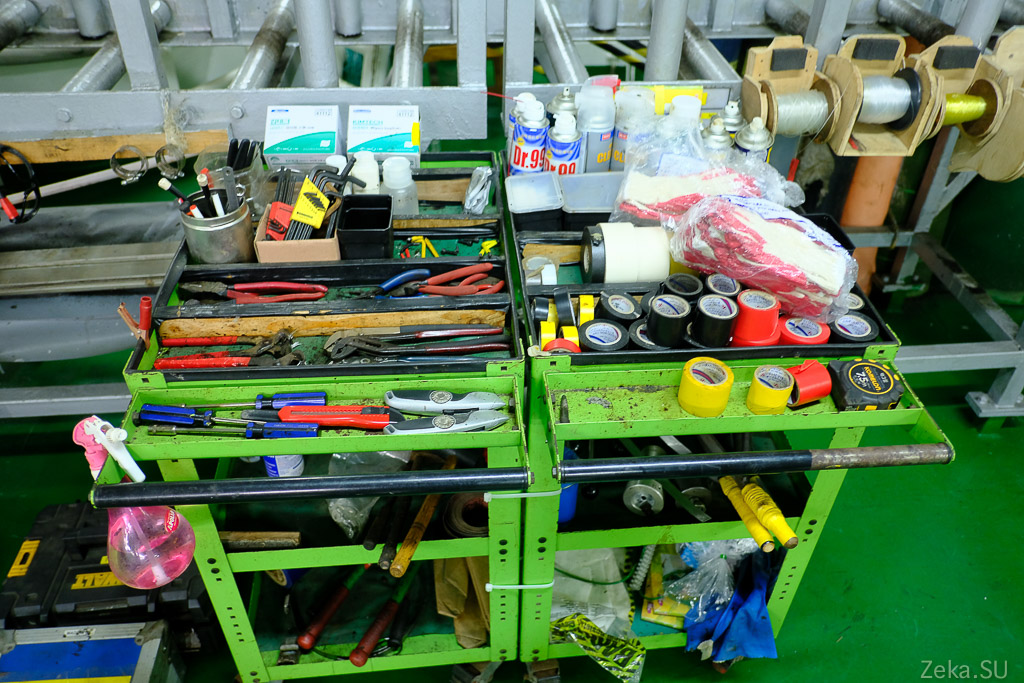
23. The welding machine
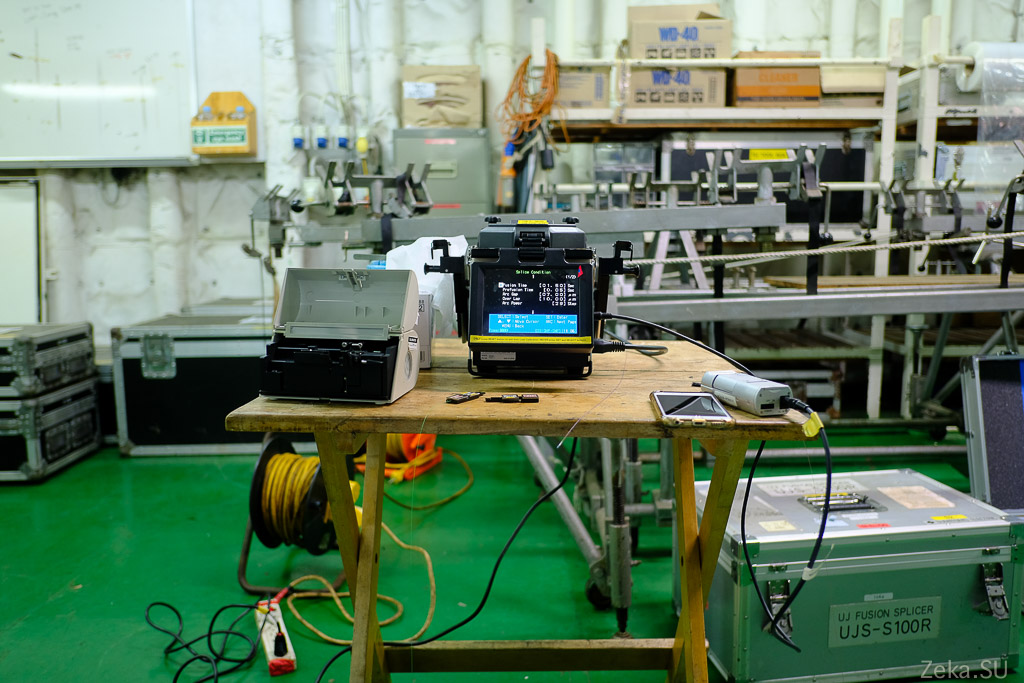
How it works can be seen here or here .
24. Bed for mounting the coupler. This is a rather large and heavy construction.

25. Alas, I do not know what it is, but I will assume that the terminal equipment for the ground station
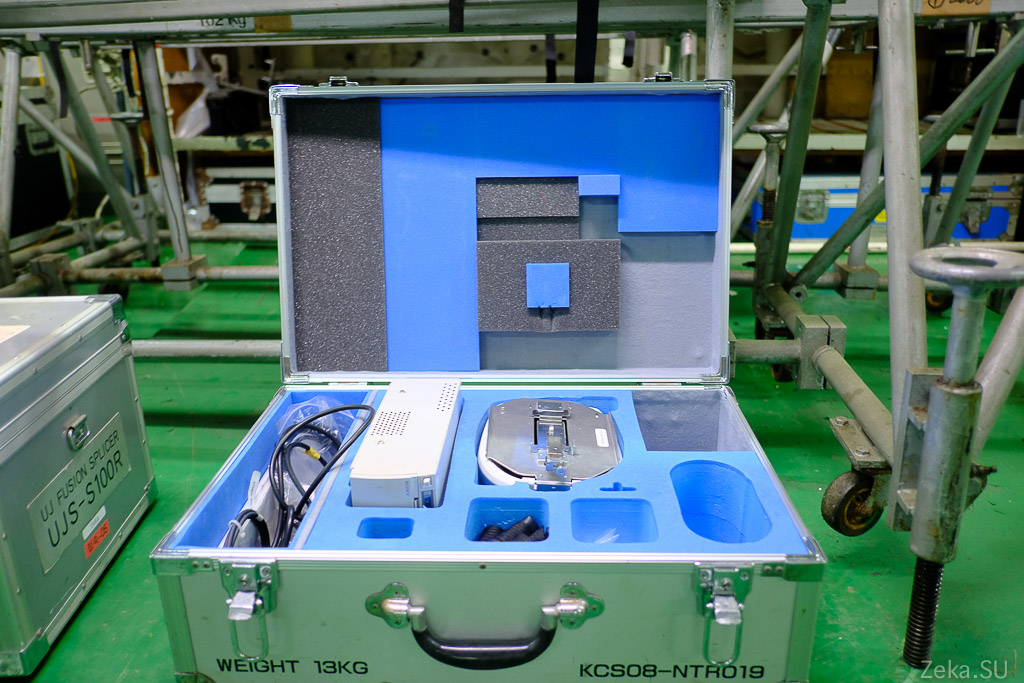
26. X-ray equipment for testing manufactured subsea couplings. You understand, it’s better to check 30 times than to bother a month with getting the cable and making a new coupling

Now we will see how the pros work and how durable this submarine cable is.
Workers cut the end of the cable to install the sleeve
27 on it .

28. First you need to braid the plastic multilayer insulation

29. The cable device. The top layer is plastic waterproofing. Next - power bearing steel cables. Underneath is a layer of polyethylene insulation. Inside a copper flexible tube. And in it already go the optical fibers

30 themselves . These bobbins did not give me rest. There is a skin for stripping the cable, and a saw in the form of strings.
It is convenient to cut plastic shells
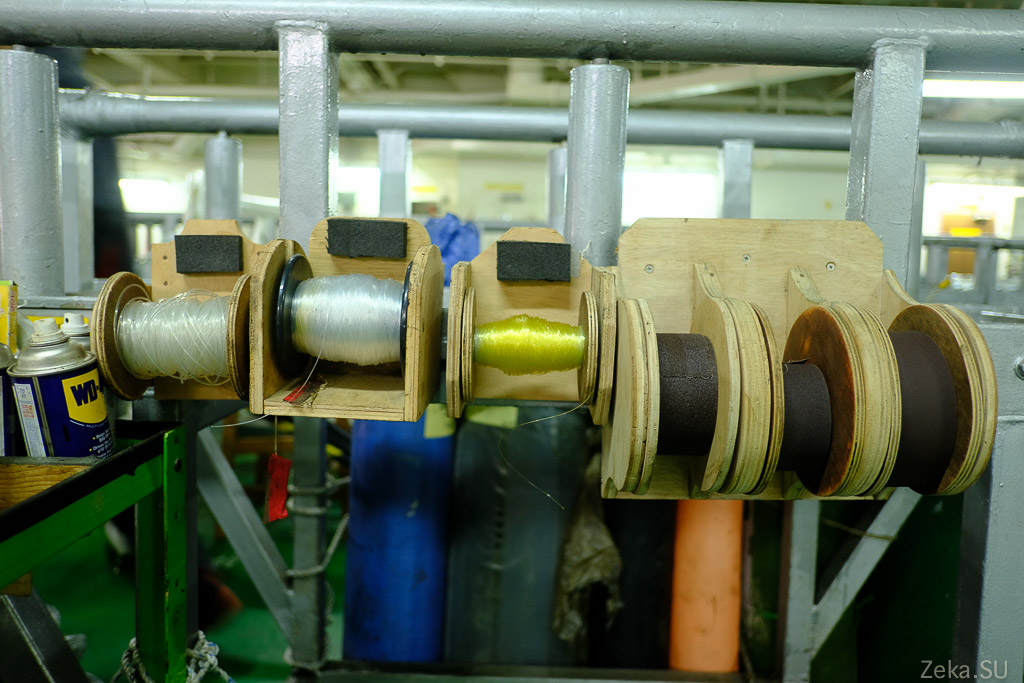
31 with such a string . But to open the power steel frame, it is necessary to use heavier artillery. Turbine and few minutes of hard work

32. What is surprising in local workers is some neglect of TB. I hope they didn’t have anything bad happened
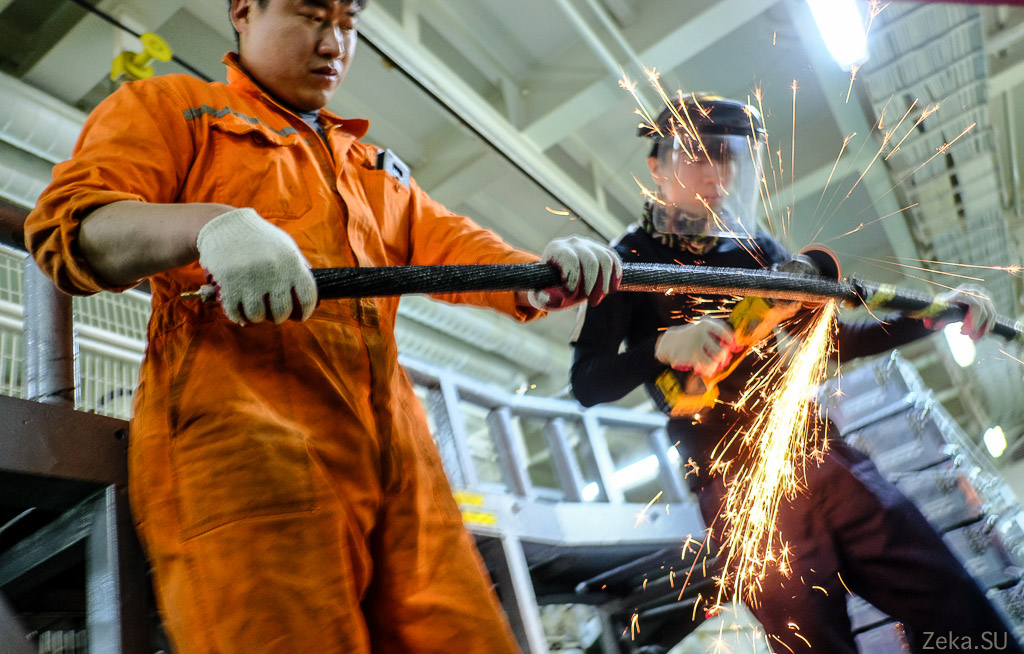
and some technical details.
It seems to lay a wire - nothing complicated. I found a picture of how much any equipment you need to install on the cable before laying. Naturally, most of all you need to install on the longest cable - Sakhalin - Iturup (top line). Next, the cable goes to Kunashir, and then to Shikotan.
By the way, an additional project of this ship was the laying of a new communication line connecting Sakhalin with large land. The cable was laid across the Tatar Strait from Vanino to Uglegorsk. But there the communication line is small in comparison with the others.

With the cable deck we are done. Let's go aft and see the underwater equipment.
The only deepwater unit on this ship is a plow.
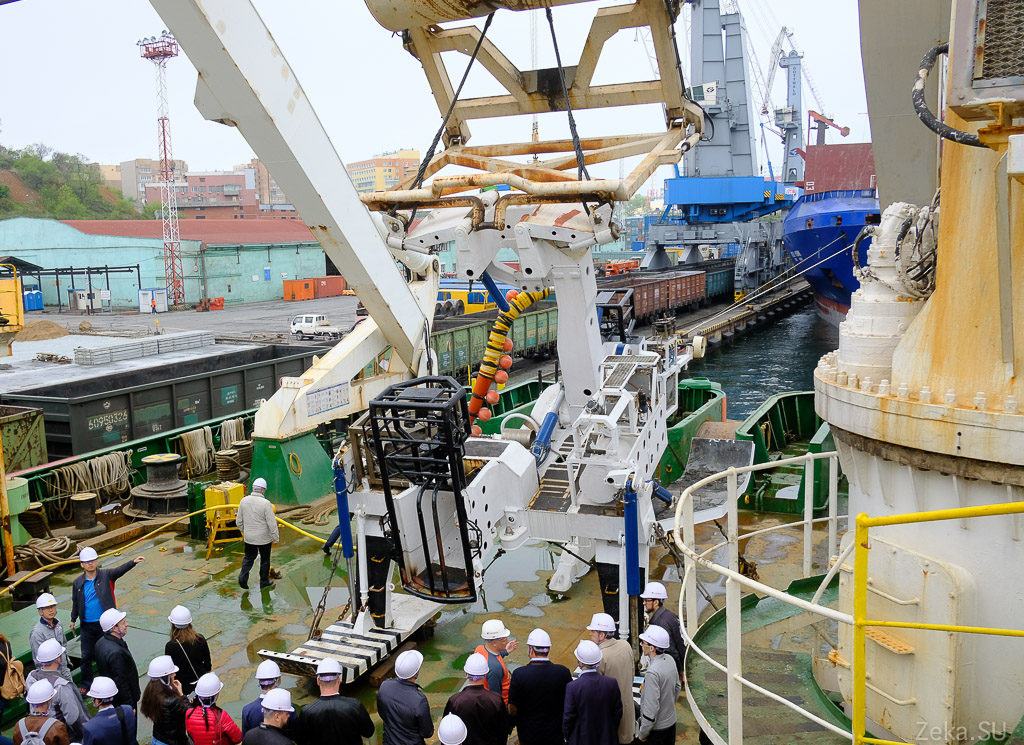
The plow sinks to the bottom on a cable and reaches for a moving ship like a regular plow across a field behind a horse. In the process of moving on command from above, the plow deepens its working fang into the bottom and digs a trench there to a depth of one meter. A channel passes through a canine and our cable immediately ends up in a trench. Which immediately can be littered with soil.
Of course, this scheme may not work on rock masses in the coastal strip, but in the ocean itself, the bottom is usually quiet and the bottom is a deposition of soft sedimentary rocks or even silt. In such soils, the plow can dig into the maximum depth of the knife. If you leave the cable lying on top, it can be damaged. For example, if one of the fishermen or scientists will trawl animals from the bottom or the shark will get too nervous. There are many examples. In shallow water where there is active shipping, the cable has to be additionally littered with a rocky for safety. Suddenly, the negligent captain will anchor near him and then pull out with his anchor all 850 km of cable.
Great video showing the plow
And another video that scares all owners of submarine cables.
The plow weighs almost 30 tons and can operate at depths of up to 1,500 meters.
A more detailed specification can be seen on the owner's website http://www.ktsubmarine.co.kr/eng/equipment/plough.asp
33. The plow in front has two skis. They stand on the ground and he goes on a ski
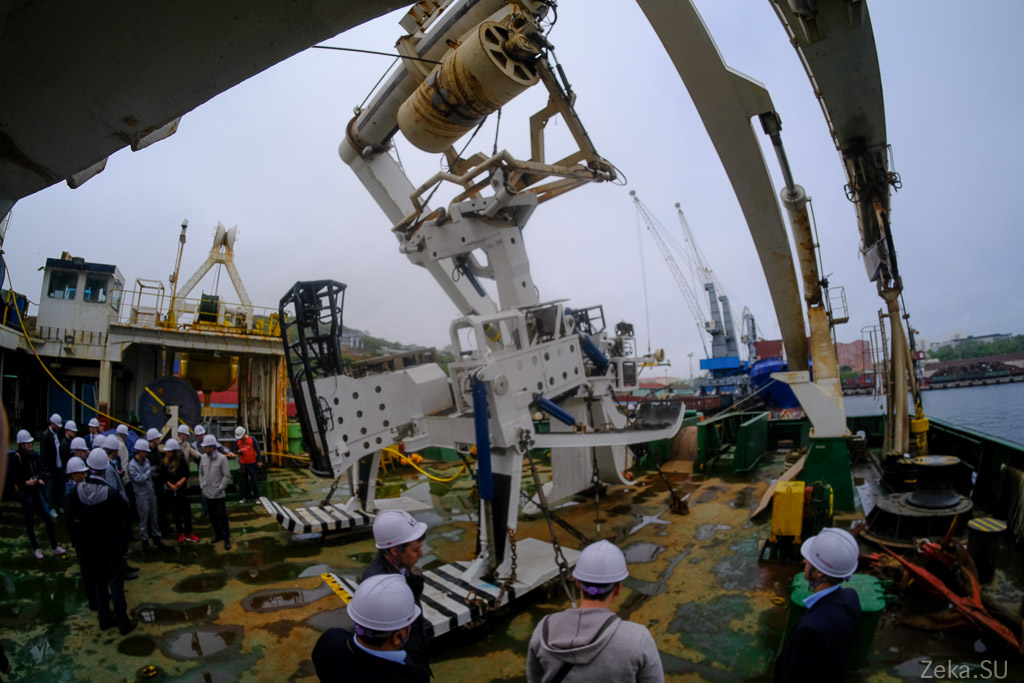
34 on a leash on these skis. At his back is a canine. The canine is buried in the ground and plows there a trench of a given depth. A cable is
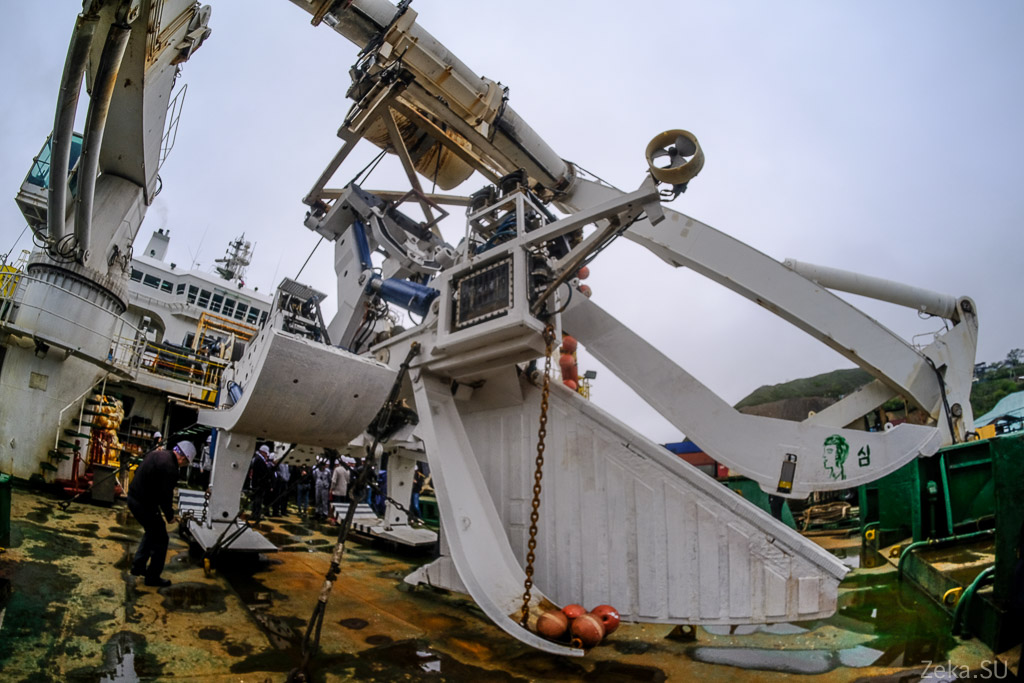
inserted into the trench along the back edge of the canine under water through a special “tongue”. Cameras, lighting and sensors are installed above the canine to monitor the operation.
The picture is transmitted to the operators on the deck.
35. What is the purpose of the little green man is incomprehensible. But I will assume that the plow has its own name in the ship's role and everyone turns to it by name
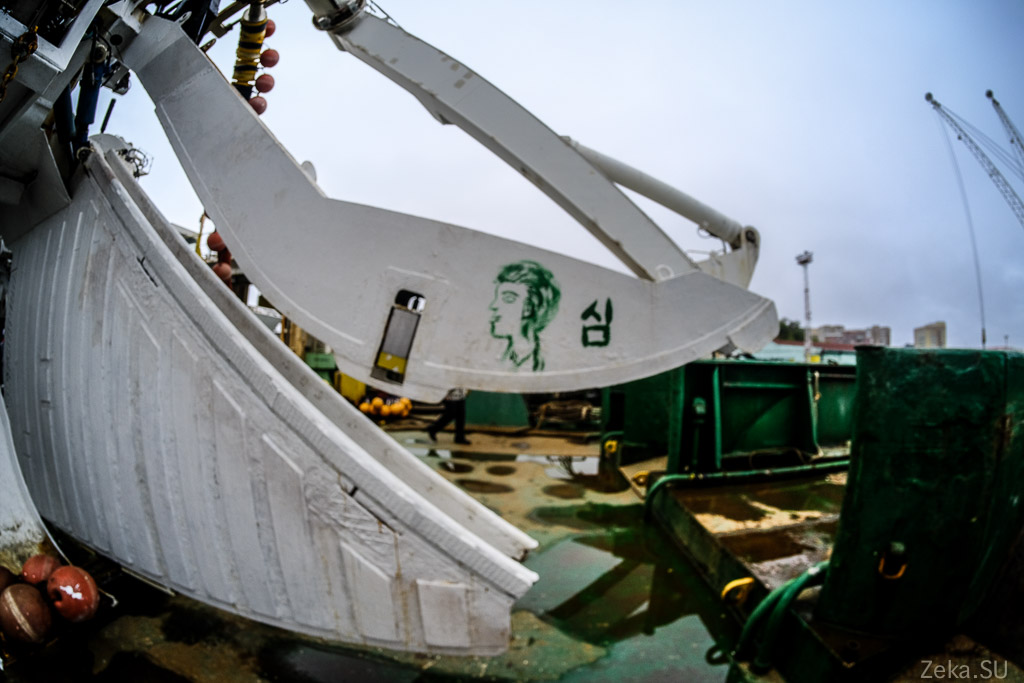
36. The "tongue" which is responsible for supplying the cable to the trench. Can go down and up I adjust the laying depth or cable tension
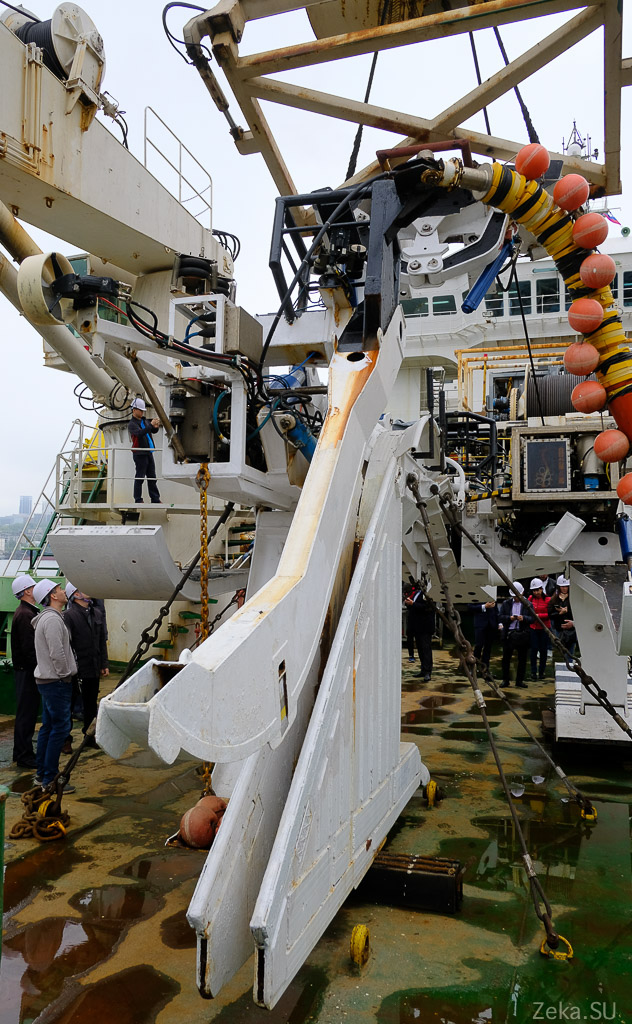
37. Close-up

38. Front view

39. The plow is a difficult thing. See a bunch of control hydraulics for lowering the canine and the back pair of skis?

40. Let's go upstairs. admire from a height. Before this, you need to familiarize yourself with TB
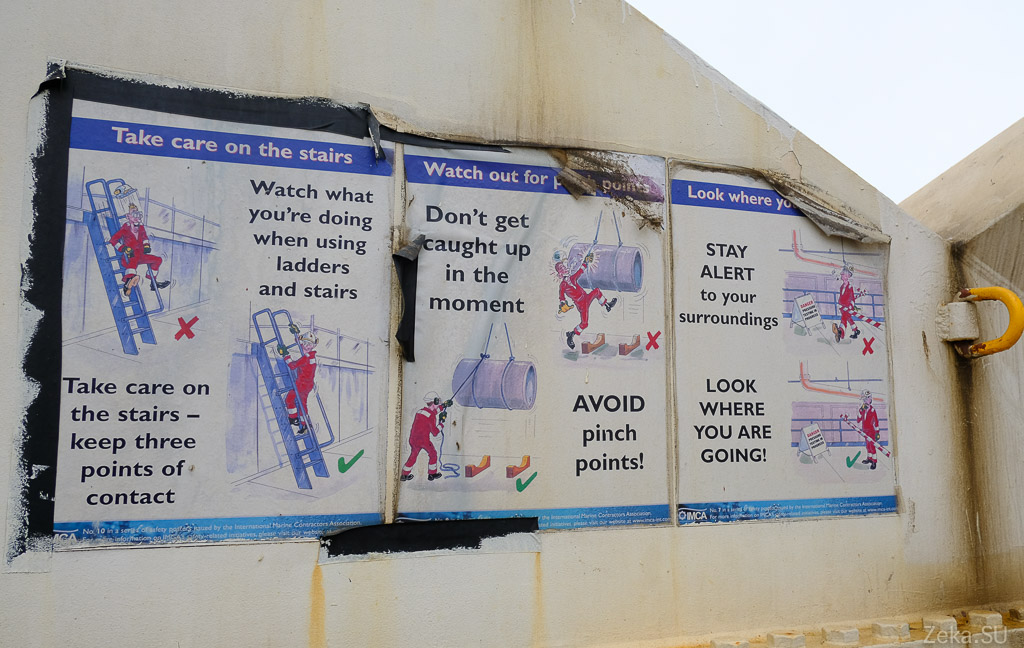
41. Plow top view. Those in white helmets are not with me.

42. Judging by the fresh color, the plow has recently been put in order. I am sure that after work it is all dirty and rusty. There is a little dirt left on the ski.
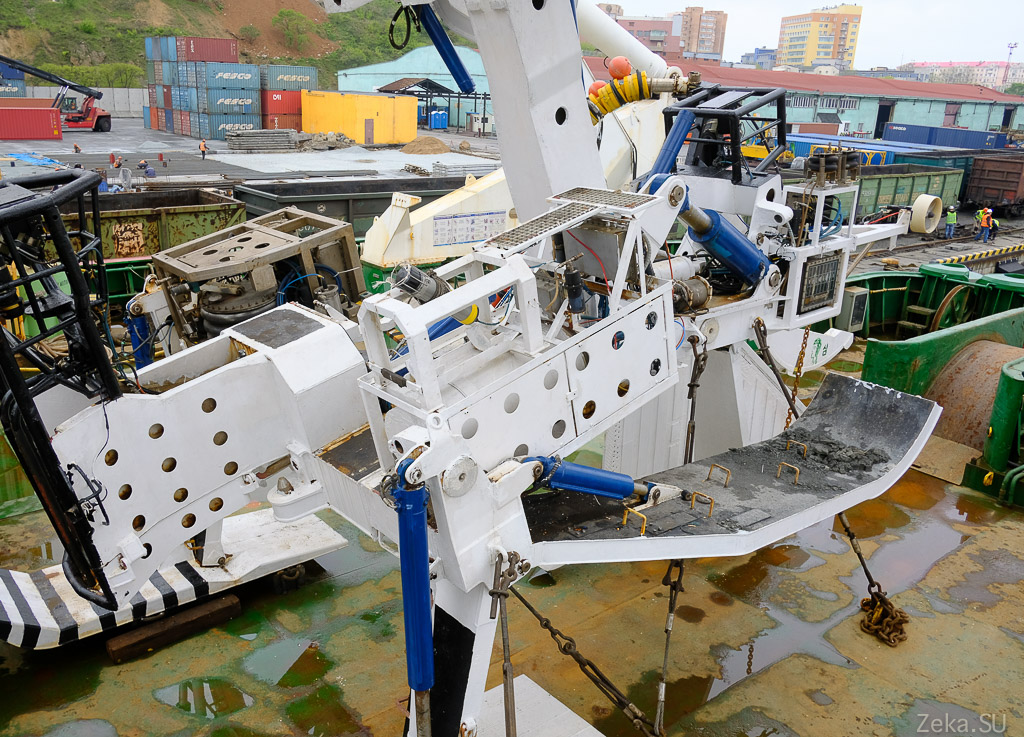
43. Above the plow is a "portal" crane which throws the plow overboard. Alas, here he did not fit into frame

44. But that’s more clear.

45. Additional crane
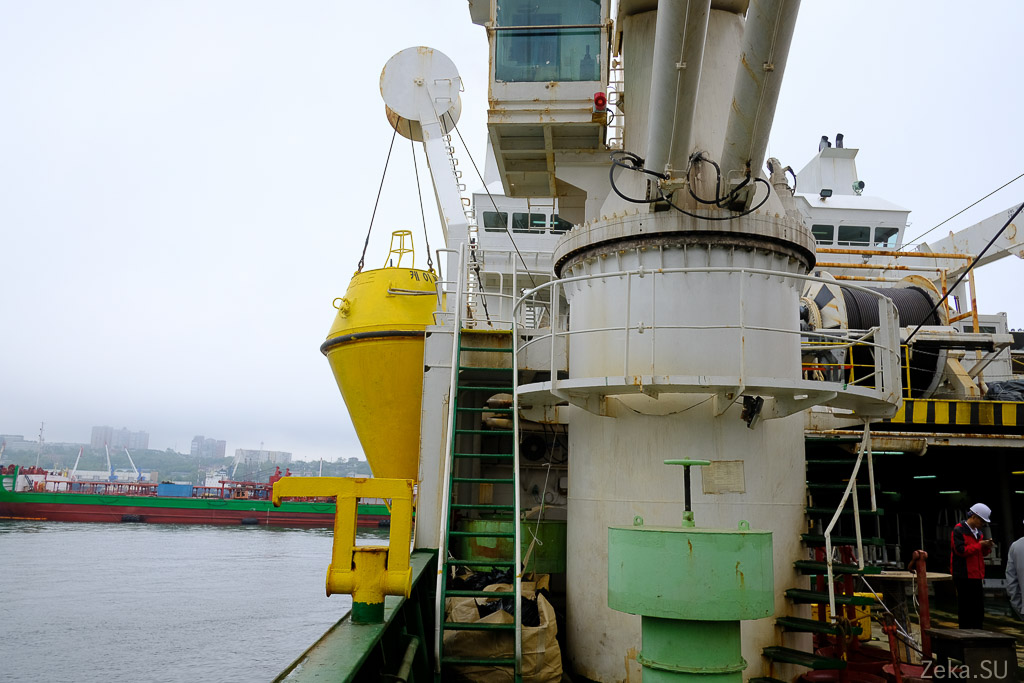
46.

An additional crane is required to work with other things except the plow. Raising the cable left for a while from work.
Just imagine, you are laying a cable, and you face a storm. What to do? Rewind 1000 km of cable?
No, everything is simple. We cut off the cable at the place where we finished. We attach a float or 10 floats to it and leave it here. We collect all the manati ourselves and sail to the protected port. At the end of the storm, we sail into place, hook the cable end on the floats with a winch and pull it onto the cable deck. We cut it, attach our end and continue laying. That's all.
48. And the stocks of all floats in our stock. Although these are more likely to bring the cable to shore.

49. The stock of anchors to secure the floats in place

50. Okay, we digress. Here is the carrier cable for lowering the plow under water

51. On the upper deck there are containers for storing all kinds of small things

52. The entrance to the cable deck is hermetically sealed in case of a storm
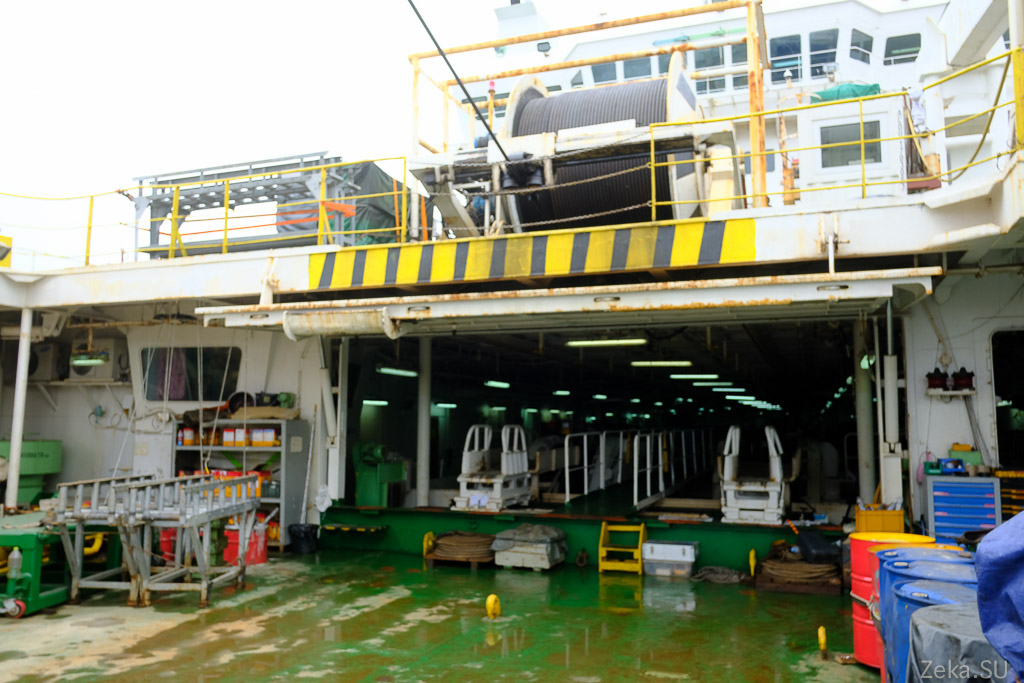
53. And this is a “drain” for the cable that will go to a depth of
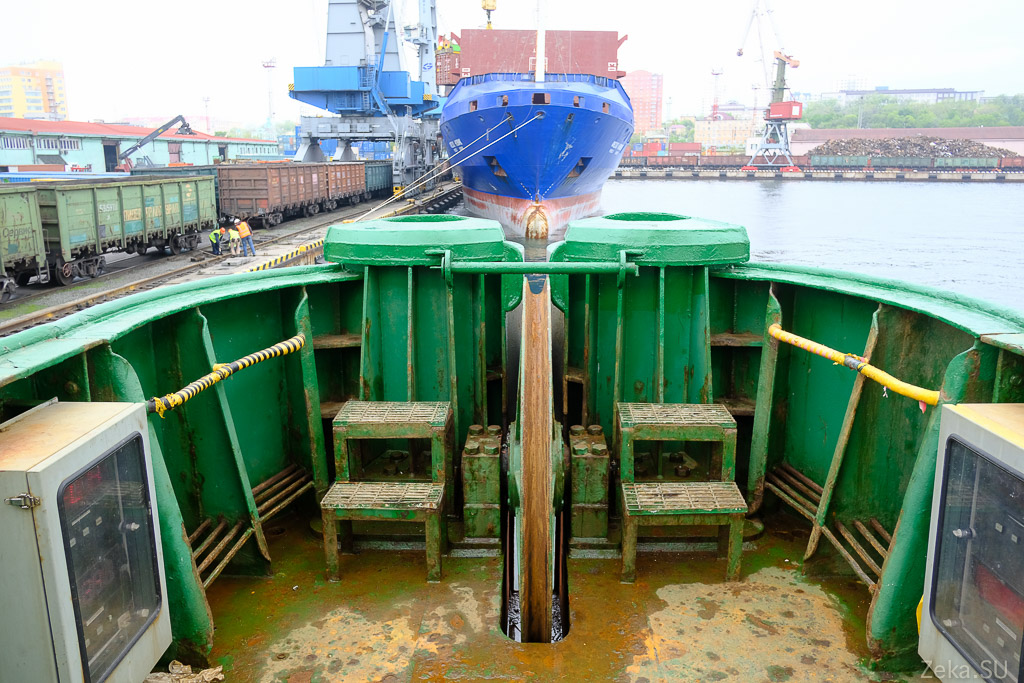
54. Perhaps we will finish the inspection of the aft deck and note that the local staff are very creative.
Here is a set of homemade and inexpensive anchors. I assume that they are disposable.
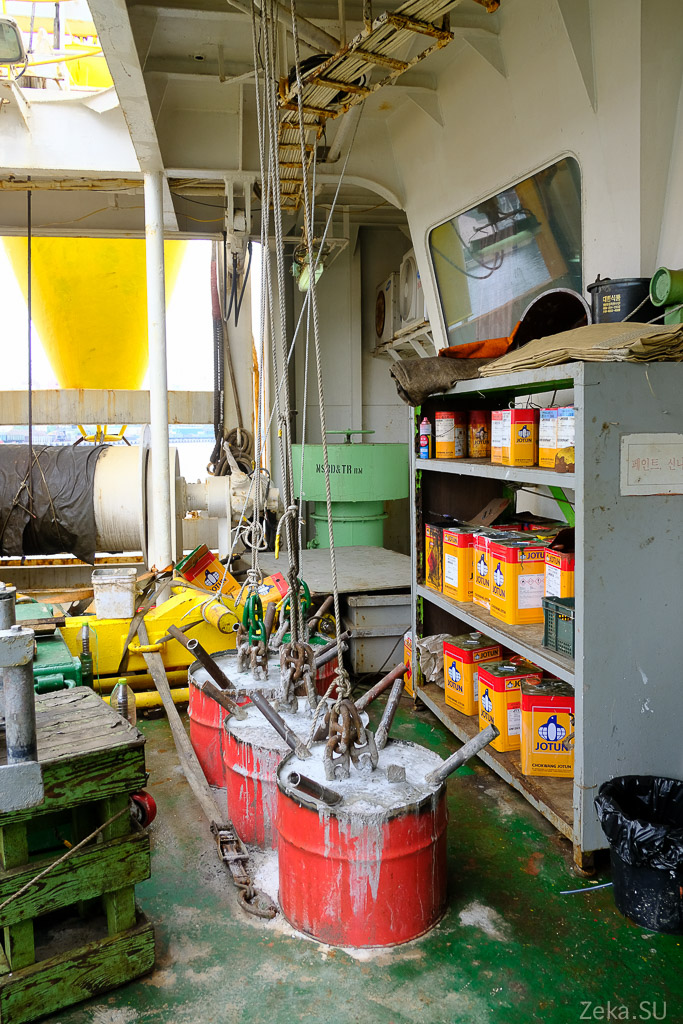
Then we will go from the heart of the ship to its control cabin ...
Actually from here all control is carried out
55. The right side

56. The left side

57. The bow of the ship. Helipad. Underneath is the dining room for the crew

58. The remote control

59. The order is right here. Everything is much better than on our Stone Age ships.
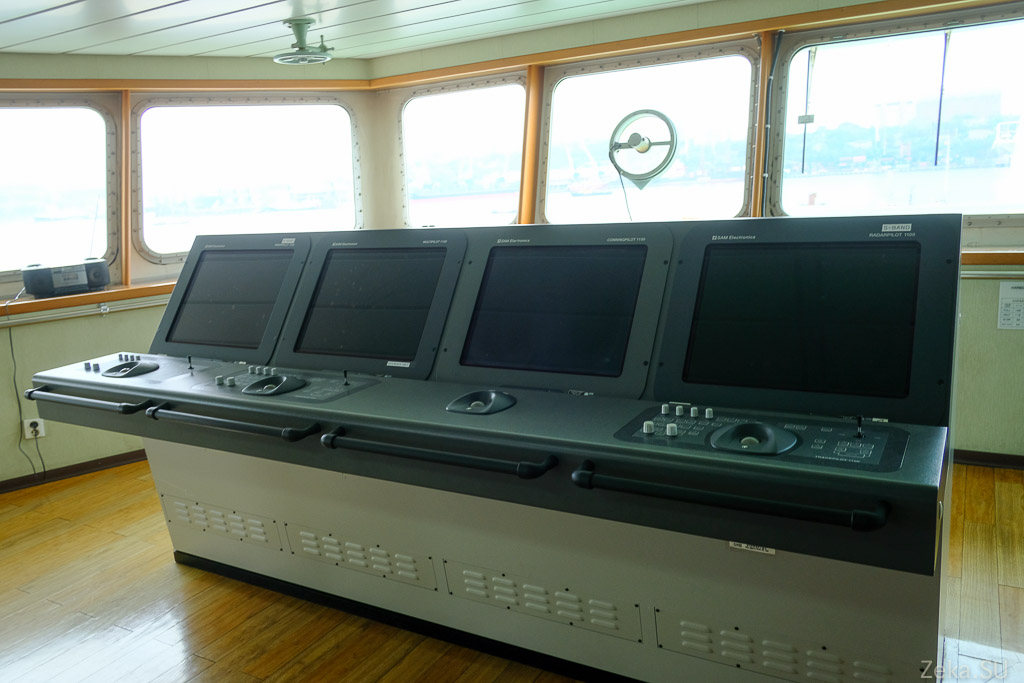
60. The place of the navigator
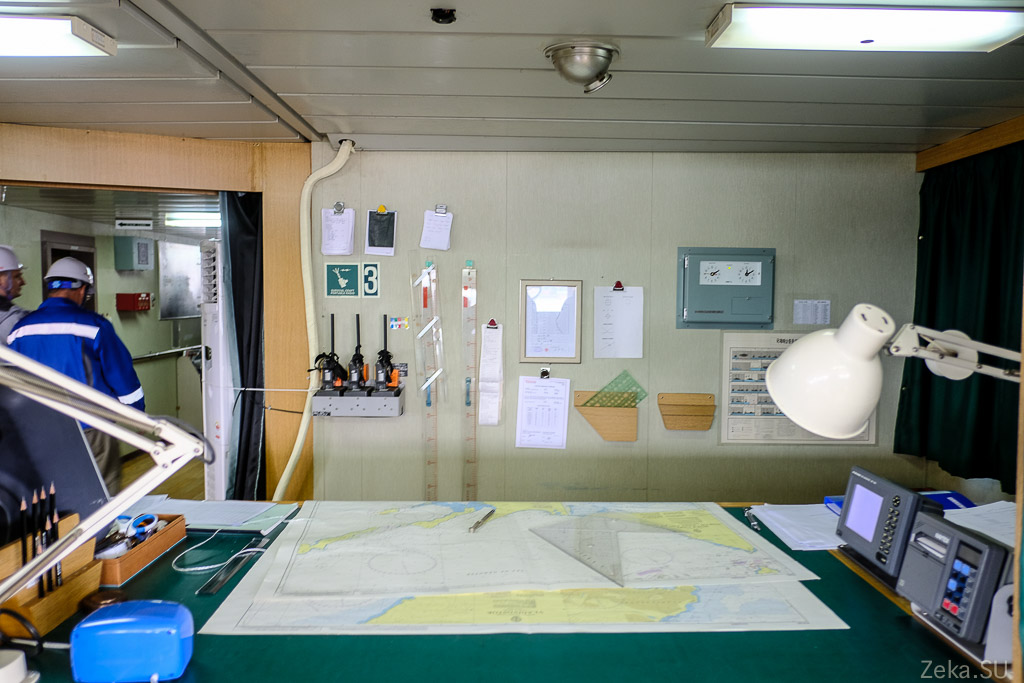
61. Scheme of the vessel. By the way, I deceived you. There are not 2 cable tanks on the vessel, but 4. On the lower diagram, two additional smaller volumes are visible
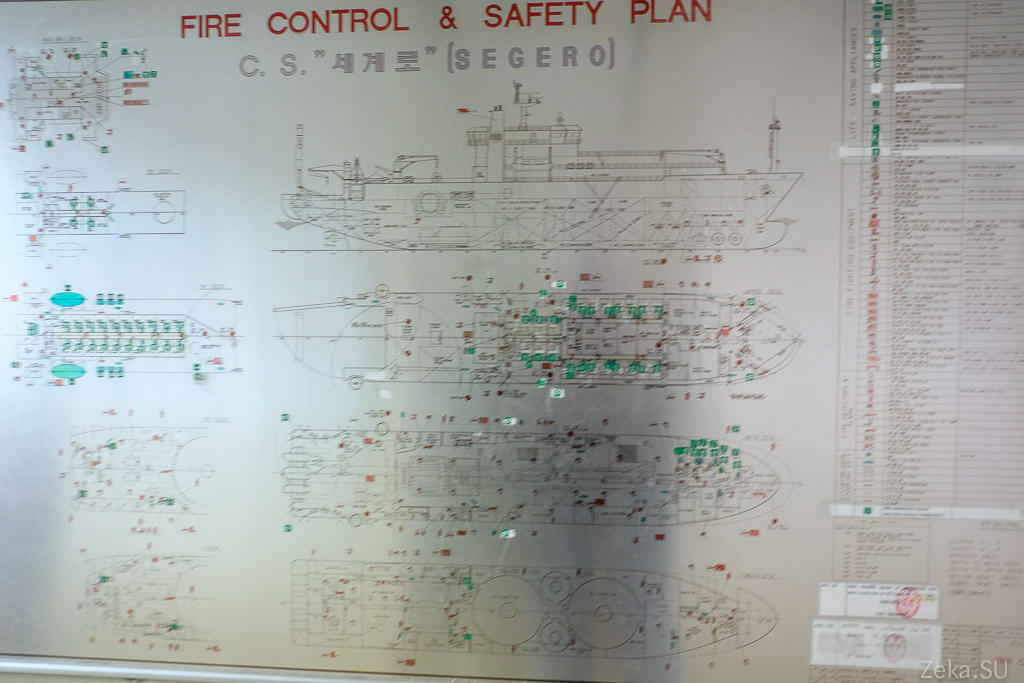
62. In the middle of the cabin there is the most important place without which problems could be captured. Great toilet. I stopped by and checked. Everything is clean
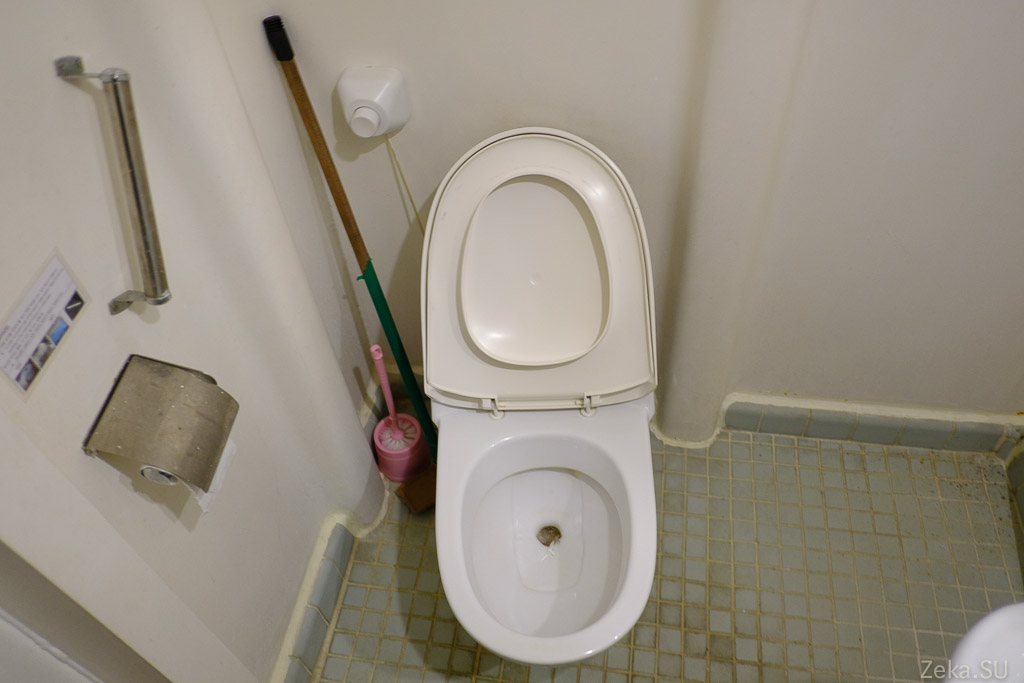
63.

64. I was secretly told that, despite a mess, toilets on Segero are many times cleaner than on CableInnovator. Do you know the indicator

65. Separate control cabin for all deepwater operations. The heart of everything.
There are operators who manage all the technological processes. plow operation, cable feed
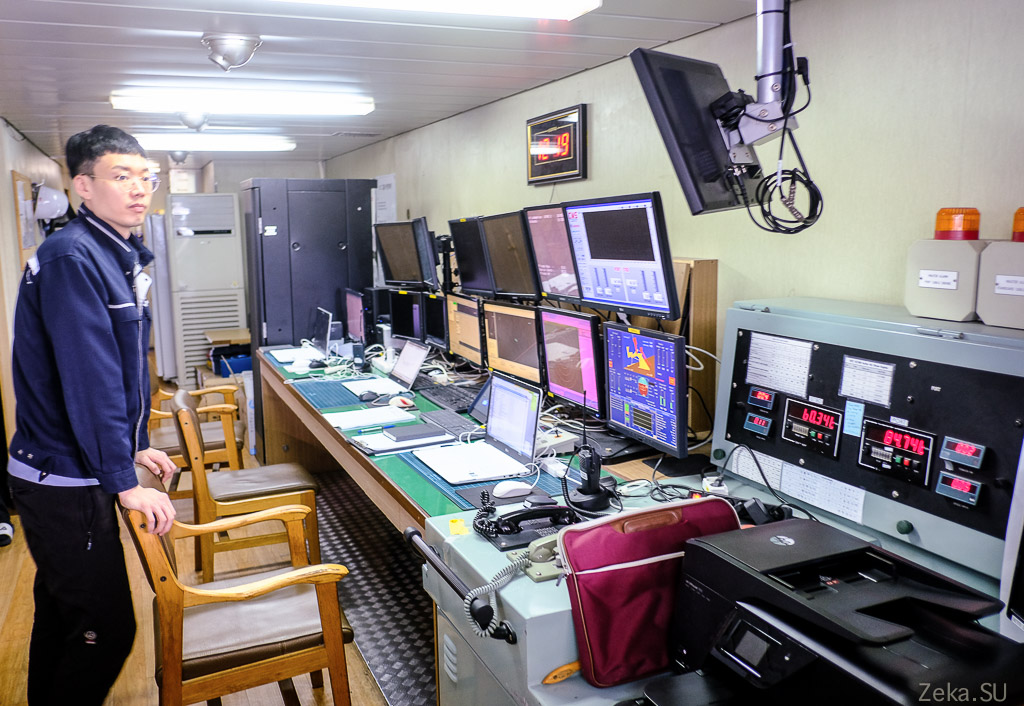
66. Radars, positioning
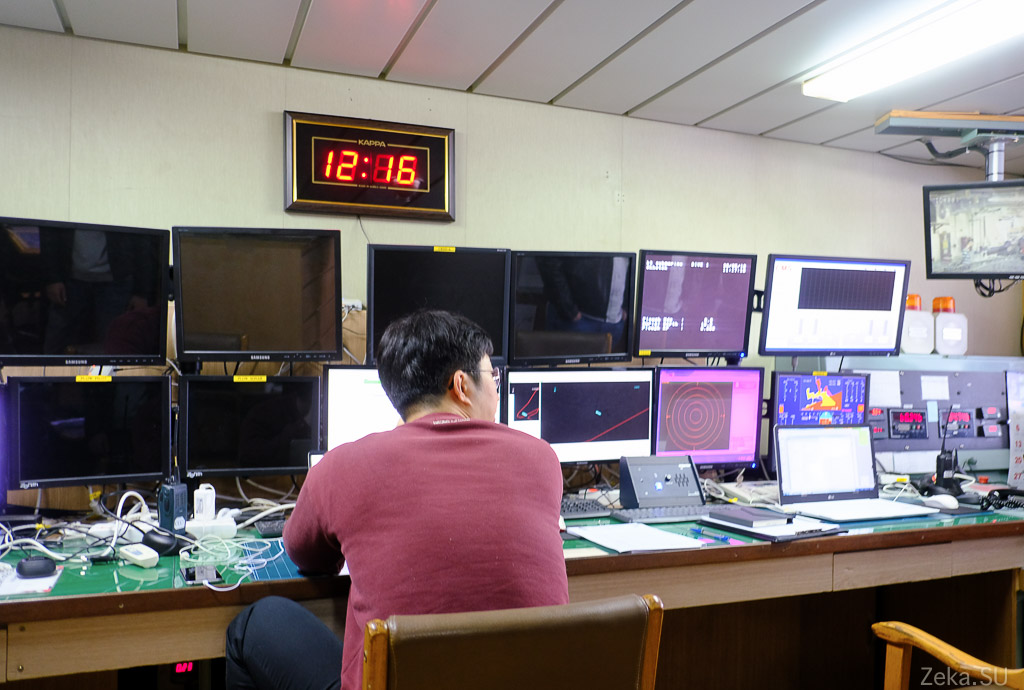
67. Communication and everything you need in one place
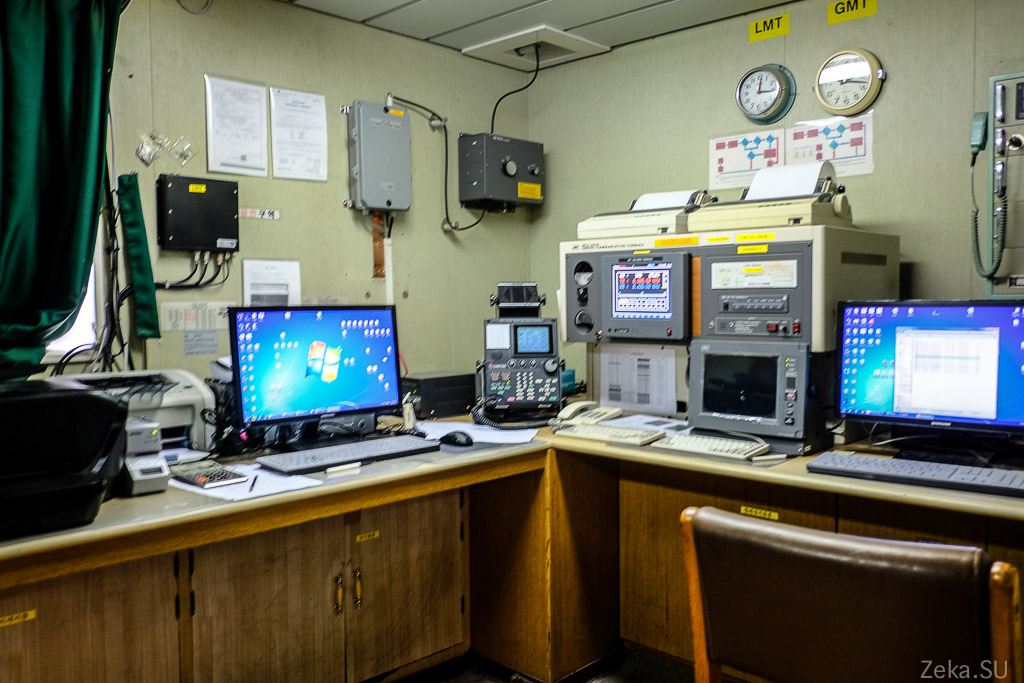
68. Another secret card. Work plans. Where and where we swim. Where are we laying

69. Alas, they did not disclose the purpose of this equipment. Probably a trade secret

70. Aft wheelhouse control, outside view
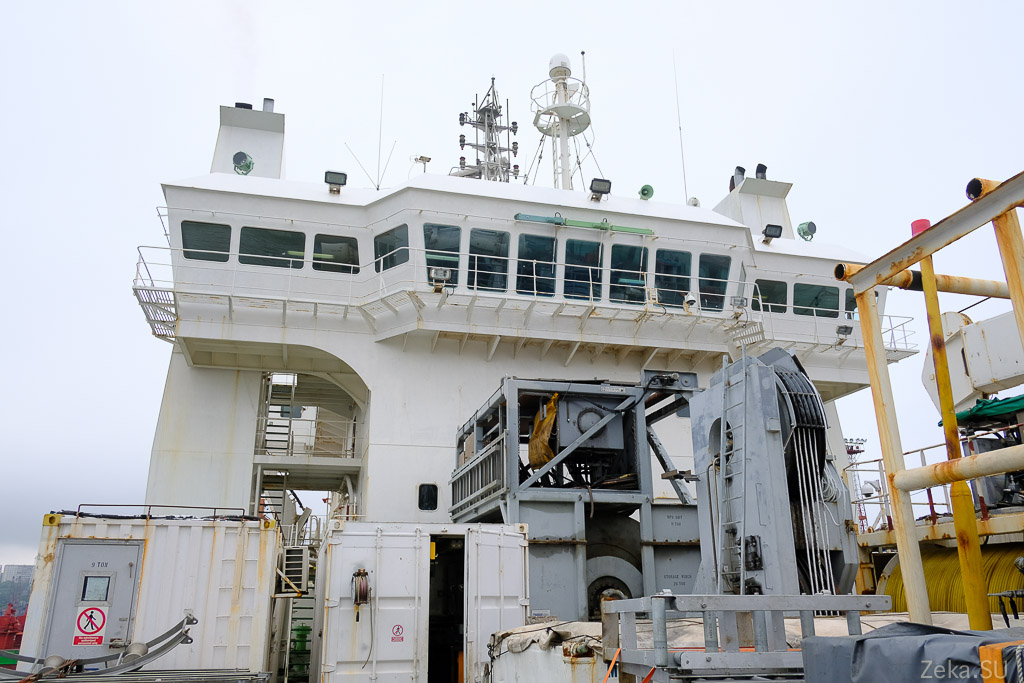
71. Remote. So I understand a lot is duplicated from the front wheelhouse

72. View of the aft deck
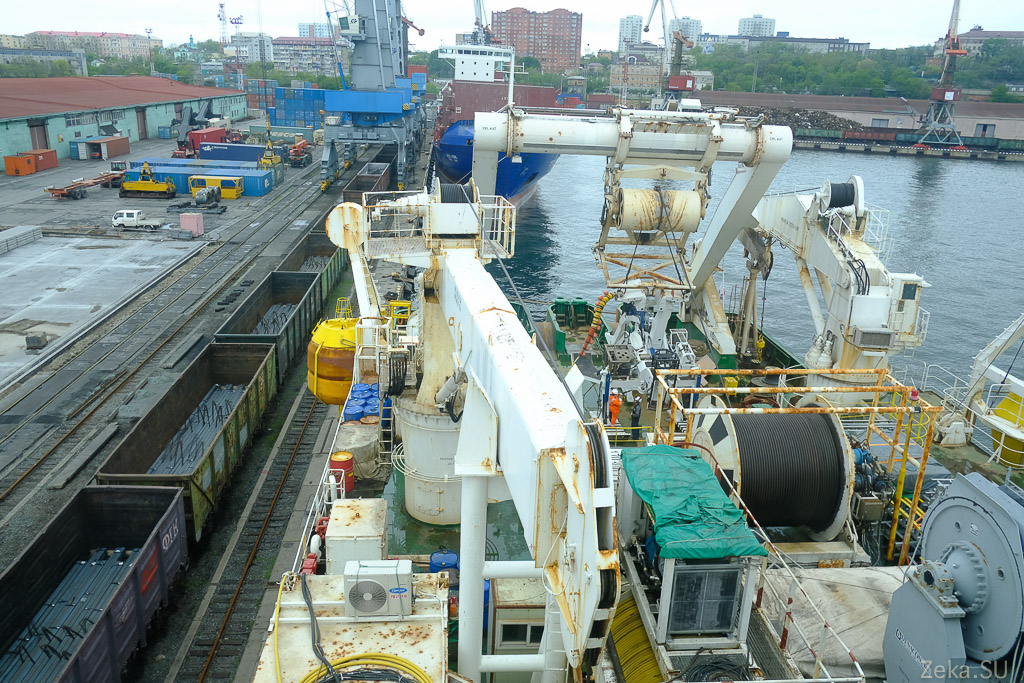
73. The plow crane and auxiliary cranes are visible.
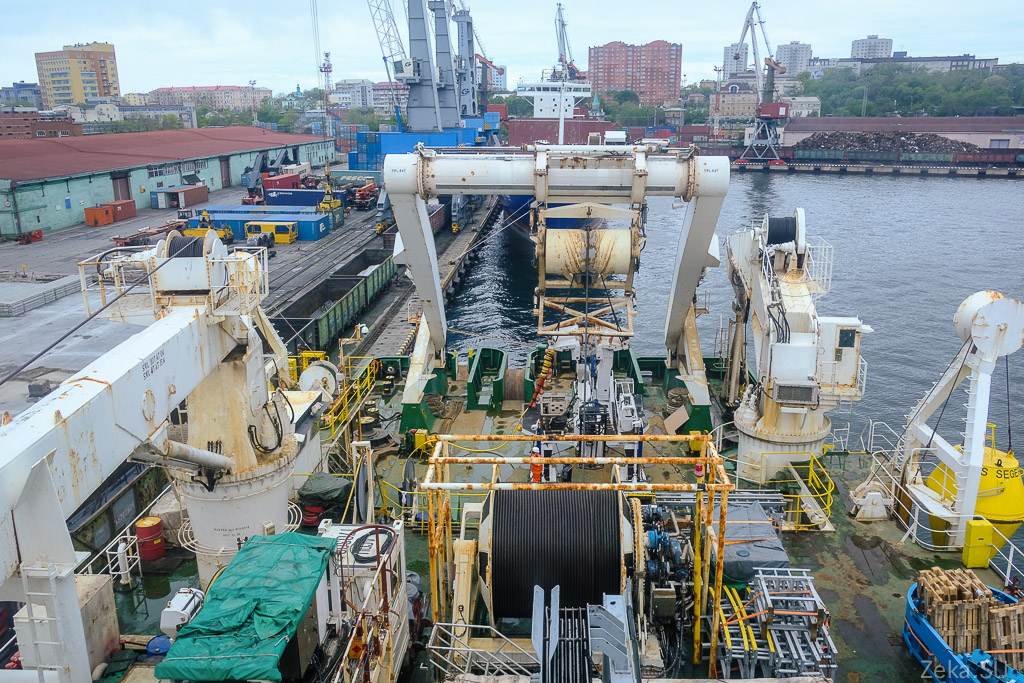
Well, and for the sake of order, let's look into the cabins of the company-dining room for the crew. Alas, it is small and will not immediately accommodate all 60 crew members.
74. They didn’t let me into the galley, but it’s immediately clear that we have only Asians here. As many as 3 rice cookers

75. From entertainment there is video and karaoke of

NU and now leave the hospitable ship and look at it from afar.
Thanks for the hospitality to everyone.
76.
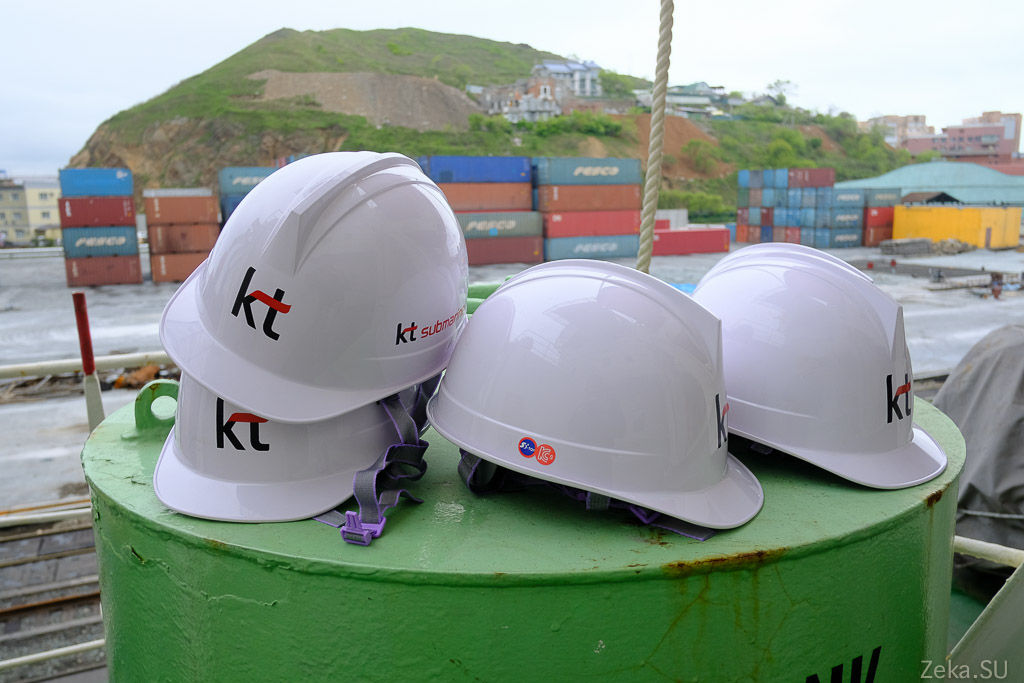
77. Parked in the commercial port
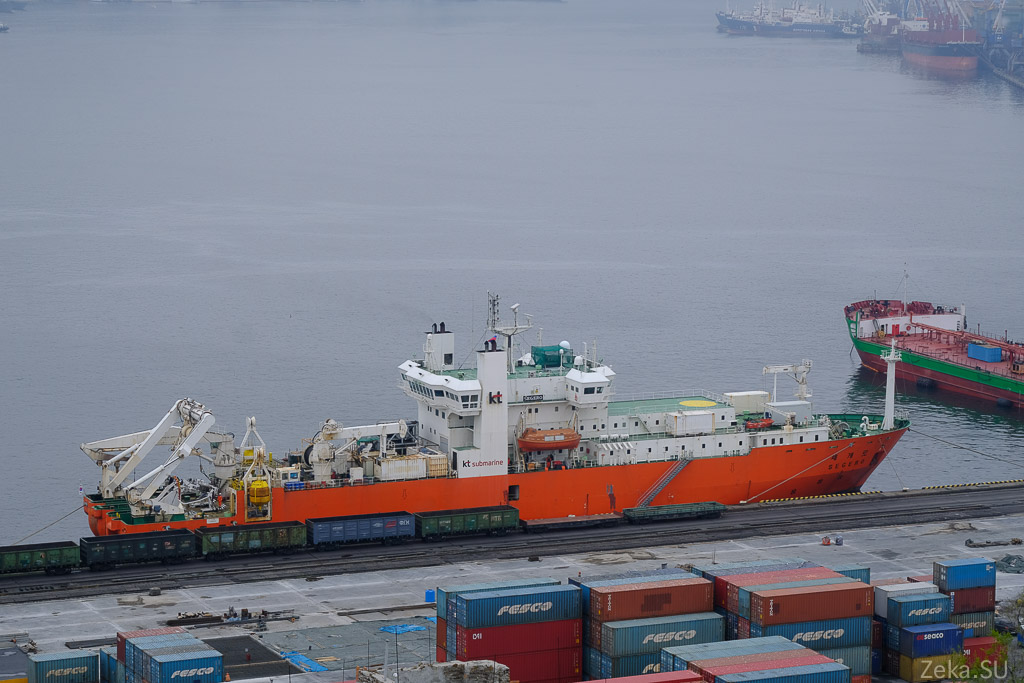
78. Feed equipment

79. Almost nothing on the bow

80.

And a short video shot in Japan about the operation of this ship.
Work on laying the line from Vanino to Sakhalin was carried out in the summer of 2018, and then the ship went to Korsakov, refuel and went to the place of work in the Sea of Okhotsk.
By October, laying work had already been completed and commissioning had begun.
The coast stations were connected to communication centers in Kurilsk, Yuzhno-Kurilsk, and Krabzavodsk. And updated communication lines were laid to the nearest settlements: Hot Beach, Raidovo, Malokurilskoye. Alas, the remaining settlements have not yet been connected because of their remoteness. But there is only a matter of technology. It is necessary to lay ground optical cables and all. They promise that in 2019, Mendeleevo and Yasnoe Airport will be connected to the fast Internet.
Alas, I do not have data on the road map. But since 2019, Rostelecom has begun a project to connect the last mile of fast Internet in villages with up to 100 residents. (It used to be up to 200) This is a project to Eliminate Digital Inequality and it is possible within the framework of this project that the others will be connected.
In February, a group of high-ranking officials made their way to Shikotan and solemnly opened the Internet connection at state institutions. School, house of culture, rural administration.
Alas, I did not find photos from the event on the Internet. Here is the only one. From the club of the village of Krabzavodskoye - Shikotan.
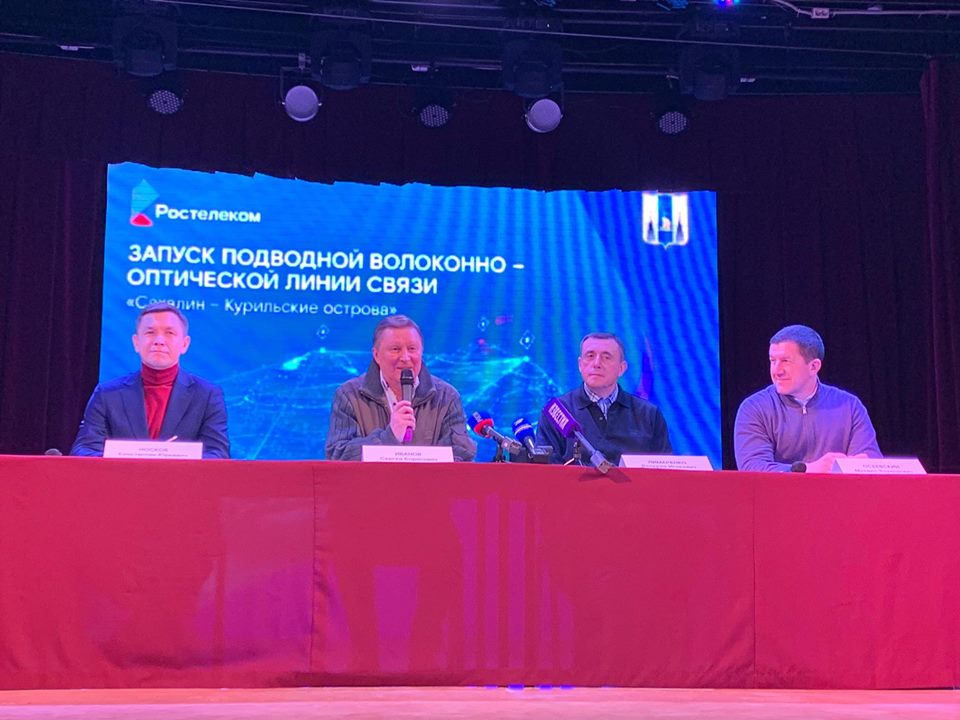
Well, there is a report of the 1st channel. They show a little the ship itself and even the rack in the communication node. The rest is all officialdom.
https://www.1tv.ru/news/2019-02-26/361072-zhiteli_yuzhnyh_kuril_poluchili_dostup_k_vysokoskorostnomu_internetu
That's all. We thank Rostelecom for the privilege of visiting such an interesting vessel.
10 years ago we were glad that the optical communication lines crossed the Tatar Strait, three years ago we admired the fact that we had finished laying optics on Magadan, and a couple of years ago on Kamchatka.
And then came the turn of the South Kuril Islands.
This fall, optics came to the three Kuril Islands. Iturup, Kunashir and Shikotan.
As usual, I tried how much it was in my power to follow up on this matter and I will tell you that everything has already been laid , tested and officially put into operation a couple of weeks ago .
At the invitation of Rostelecom, I managed to visit a ship that was carrying out cable laying work.
The state, represented by Rostelecom, acted as the customer; as the last time, the company was Huawei.
But the cable laying vessel was already different.
Naturally, in the process of laying the cable, there were some political problems with the neighbors . But it seems like nothing further than the notes of protest did not go. Although the devil knows what the situation will go there. But this is a matter of politics already, we will probably keep silent about it.
Korean Segero 1998 release.

The specification of the vessel on the site .
Who cares about other cable-laying ships - here's a great selection for you to admire .
In 2017, the same team that built the line to Magadan and Kamchatka conducted reconnaissance work in the Sea of Okhotsk on our hydrographic vessels, and in 2018 in May, the ship arrived in Vladivostok, took the team and technical specialists and went to the work area for direct installation.

You had a unique opportunity to walk along the ship with the cable layer and see what and how.
Alas, no one else will tell you this, as last time, in a story about another Cable Layer .

++++++++++++++++++++++++++++++++++++++++++++++++++++ ++++++++++++++++++++++++++++++++++++++
If you do not know or have forgotten how to lay underwater communication lines, I’ll remind you the stages of laying underwater communication lines:
1 Research and Design
At this stage, the bottom of the sea is examined, or ready-made materials from previous studies are taken. Depending on the topography of the bottom, a route is laid. Naturally, current communications at the bottom are also taken into account. But the benefit is that the Sea of Okhotsk is not rich in underwater pipelines and underwater optical highways, except perhaps secret Pacific Fleet communications cables to which enemy submarines listen .
A hydrographic vessel sets off to the site of work and studies of the day, topography, and determination of cable exit points to the surface on the shore are performed.
2 Cable manufacturing and loading
The cable is made immediately with a single coil so that under ideal conditions it can be laid from beginning to end, and loaded onto the ship. At the production stage, EDFA (Erbium Doped Fiber Amplifier), a fiber-optic amplifier based on erbium-doped optical fiber, is immediately integrated into the cable.
Due to the fact that Russia does not have such civilian ships, the manufacture of the cable and its laying were assigned to Huawei.
Huawei has no fleet and for this reason hired a subcontractor, kt submarine, a Korean company specializing in underwater operations.
3 Gasket
Everything is simple here. At the bottom, from the ship, lower the plow and turn the small forward. He digs a trench, a cable is buried in it.

The only difference with the picture is that under the ship the depth is a couple of kilometers.
Here's another informative video:
4 Connection to the shore
If everything went well and the cable reached from coast to coast, then it is connected to the coast station. To do this, thoroughly bury the cable at the connection point in the bottom so that it is not washed by the sea, heap with stones. Connect the earth's end with the sea.
This is how it looks close:
5 Testing and commissioning
After the work is completed, the wires are stuck, losses are measured, communication is started. If everything works, consumers are connected. Usually they start at a minimum speed, but in the cable usually there are additional wires, through which later, when replacing equipment, you can start large amounts of traffic transfer. Well, again, the reserve, suddenly that will break.
In the description of the process, all kinds of approvals of money and work are omitted, but in our case this is no longer very important.
++++++++++++++++++++++++++++++++++++++++++++++++++++ ++++++++++++++++++++++++++++++++++++++++++
Cable Stacker Segero
1 And now, we will step aboard the Segero ship and walk a bit.

2 The first thing that we have to do is ... yes that's right, we will put on protective equipment so as not to hit our head where it is not necessary.

3 Last time I didn’t think about how cables were loaded onto a ship. It turns out there are special “filling necks”. I honestly thought just through the open door on board.

The main distinguishing modules of the cable-laying vessel are
- Cable deck. It performs all work with the cable. Cutting, fixing, transfer of the cable to the outside and so on. On the cable deck, it is worthwhile to separately distinguish the wet storage of amplifiers. (underwater signal amplifiers need to be stored in a humid environment). “Clean room” - required for cable welding. X-ray cabinet - to check the quality of connections.
- Cable tanks. Capacities in the form of barrels where stocks of cable are stored.
- Aft deck with cranes and laying tools. They usually place subsea equipment for laying and cranes to control this heavy equipment. Also control panels.
- Own underwater equipment plow and additional underwater robots.
- Additional felling. Since it is often required to very accurately position the ship at sea during work, the cabin is usually double, front and rear. So that the helmsman could control the process from all sides.
The rest is the same as other ships, engine, cabins, galley, dining room. But only, for convenience, on such ships there are a bunch of different thrusters and automatic equipment for millimeter accuracy in keeping the ship in place.
Let's go in order.
Cable Deck
4. These mechanisms are conveyors for transferring cable from the tanks to the stern

5. Rollers for pulling the cable

6.

7. At the same time, two cables from 2 tanks can be fed simultaneously

8.

9. I don’t know what to call, but the type of cable channels. Cable

10 runs along them . Signal amplifiers

11 are stored on the deck itself . Alas, apparently there is no wet camera on board. The storage scheme was implemented using the “Wet Rag” methodology

12.

This is a direct disappointment compared to the other cable layer that I was able to visit. You yourself can go and compare http://zeka.su/2016/07/11/3406/
How signal
amplifiers work Amplifiers are most often made on the basis of doping the fiber with rare-earth element erbium.
An additional laser pump beam of high power, but different from the frequency of the laser transmitting the information, is introduced into the fiber and causes the erbium atoms in the amplifier to go into an excited unstable state. When a laser photon weakened by a long fiber-optic path with useful information collides with this atom, it receives energy from this excited atom, and is re-emitted with a new force and flies further, more precisely, it is re-emitted in the form of 2 quanta and useful photons becomes larger.
If all this is explained on the fingers, it will be so.
Tennis balls on which information is recorded are thrown into the pipe and they fly through the pipe from point A to point B. The pipe is long, and when they experience air resistance, they slow down and may not reach the end of the pipe.
But nearby, air is pumped at a high speed along a parallel pipe, and it makes the blades of a wheel type spin like a water mill, or a wheeled steamer, located somewhere in the middle of the pipe.
Having reached this wheel, tennis balls get this wheel on the ass, like a tennis racket and with renewed vigor fly on ... another 80km =)
Who cares, read the normal and useful article on this subject , well, or Wikipedia .
sorry for the confusion, but I'm not very strong in these matters.
But in more detail it is possible to read on Habré in kamenty
13. Also on this deck storage of the additional equipment for laying is carried out. Couplings, adapters and so on. In short, a bunch of any consumables

14. Here you can go to sea =)

15. Here are the suspicious boxes that interest me

16. This is just an optical coupler for installation in a shore wiring closet. This is the very end of the cable. The terminal equipment will already be connected to it. In the coupling it is just visible that 4 veins are divorced.

17. Alas, I don’t know what it is, but also probably spare parts and other parts

18. Visual aid for laying

On the cable deck there are naturally two cable tanks - storage.
19. They contain 850 km of cable + reserve.

20. Second vault

21. Tank walls are rounded so that the cable slides and does not fray

Now let's look into the "clean room." There, work is done on cutting the cable, welding optics and installing couplings, amplifiers and so on.
22. Workbench. Pay attention to homemade bobbins for materials

Tools and a bunch of all kinds of electrical tape.

23. The welding machine

How it works can be seen here or here .
24. Bed for mounting the coupler. This is a rather large and heavy construction.

25. Alas, I do not know what it is, but I will assume that the terminal equipment for the ground station

26. X-ray equipment for testing manufactured subsea couplings. You understand, it’s better to check 30 times than to bother a month with getting the cable and making a new coupling

Now we will see how the pros work and how durable this submarine cable is.
Workers cut the end of the cable to install the sleeve
27 on it .

28. First you need to braid the plastic multilayer insulation

29. The cable device. The top layer is plastic waterproofing. Next - power bearing steel cables. Underneath is a layer of polyethylene insulation. Inside a copper flexible tube. And in it already go the optical fibers

30 themselves . These bobbins did not give me rest. There is a skin for stripping the cable, and a saw in the form of strings.
It is convenient to cut plastic shells

31 with such a string . But to open the power steel frame, it is necessary to use heavier artillery. Turbine and few minutes of hard work

32. What is surprising in local workers is some neglect of TB. I hope they didn’t have anything bad happened

and some technical details.
It seems to lay a wire - nothing complicated. I found a picture of how much any equipment you need to install on the cable before laying. Naturally, most of all you need to install on the longest cable - Sakhalin - Iturup (top line). Next, the cable goes to Kunashir, and then to Shikotan.
By the way, an additional project of this ship was the laying of a new communication line connecting Sakhalin with large land. The cable was laid across the Tatar Strait from Vanino to Uglegorsk. But there the communication line is small in comparison with the others.

With the cable deck we are done. Let's go aft and see the underwater equipment.
Aft deck
The only deepwater unit on this ship is a plow.

The plow sinks to the bottom on a cable and reaches for a moving ship like a regular plow across a field behind a horse. In the process of moving on command from above, the plow deepens its working fang into the bottom and digs a trench there to a depth of one meter. A channel passes through a canine and our cable immediately ends up in a trench. Which immediately can be littered with soil.
Of course, this scheme may not work on rock masses in the coastal strip, but in the ocean itself, the bottom is usually quiet and the bottom is a deposition of soft sedimentary rocks or even silt. In such soils, the plow can dig into the maximum depth of the knife. If you leave the cable lying on top, it can be damaged. For example, if one of the fishermen or scientists will trawl animals from the bottom or the shark will get too nervous. There are many examples. In shallow water where there is active shipping, the cable has to be additionally littered with a rocky for safety. Suddenly, the negligent captain will anchor near him and then pull out with his anchor all 850 km of cable.
Great video showing the plow
And another video that scares all owners of submarine cables.
Plow
The plow weighs almost 30 tons and can operate at depths of up to 1,500 meters.
A more detailed specification can be seen on the owner's website http://www.ktsubmarine.co.kr/eng/equipment/plough.asp
33. The plow in front has two skis. They stand on the ground and he goes on a ski

34 on a leash on these skis. At his back is a canine. The canine is buried in the ground and plows there a trench of a given depth. A cable is

inserted into the trench along the back edge of the canine under water through a special “tongue”. Cameras, lighting and sensors are installed above the canine to monitor the operation.
The picture is transmitted to the operators on the deck.
35. What is the purpose of the little green man is incomprehensible. But I will assume that the plow has its own name in the ship's role and everyone turns to it by name

36. The "tongue" which is responsible for supplying the cable to the trench. Can go down and up I adjust the laying depth or cable tension

37. Close-up

38. Front view

39. The plow is a difficult thing. See a bunch of control hydraulics for lowering the canine and the back pair of skis?
40. Let's go upstairs. admire from a height. Before this, you need to familiarize yourself with TB

41. Plow top view. Those in white helmets are not with me.

42. Judging by the fresh color, the plow has recently been put in order. I am sure that after work it is all dirty and rusty. There is a little dirt left on the ski.

43. Above the plow is a "portal" crane which throws the plow overboard. Alas, here he did not fit into frame

44. But that’s more clear.

45. Additional crane

46.

An additional crane is required to work with other things except the plow. Raising the cable left for a while from work.
Just imagine, you are laying a cable, and you face a storm. What to do? Rewind 1000 km of cable?
No, everything is simple. We cut off the cable at the place where we finished. We attach a float or 10 floats to it and leave it here. We collect all the manati ourselves and sail to the protected port. At the end of the storm, we sail into place, hook the cable end on the floats with a winch and pull it onto the cable deck. We cut it, attach our end and continue laying. That's all.
48. And the stocks of all floats in our stock. Although these are more likely to bring the cable to shore.

49. The stock of anchors to secure the floats in place

50. Okay, we digress. Here is the carrier cable for lowering the plow under water

51. On the upper deck there are containers for storing all kinds of small things

52. The entrance to the cable deck is hermetically sealed in case of a storm

53. And this is a “drain” for the cable that will go to a depth of

54. Perhaps we will finish the inspection of the aft deck and note that the local staff are very creative.
Here is a set of homemade and inexpensive anchors. I assume that they are disposable.

Then we will go from the heart of the ship to its control cabin ...
Cutting
Actually from here all control is carried out
55. The right side

56. The left side

57. The bow of the ship. Helipad. Underneath is the dining room for the crew

58. The remote control

59. The order is right here. Everything is much better than on our Stone Age ships.

60. The place of the navigator

61. Scheme of the vessel. By the way, I deceived you. There are not 2 cable tanks on the vessel, but 4. On the lower diagram, two additional smaller volumes are visible

62. In the middle of the cabin there is the most important place without which problems could be captured. Great toilet. I stopped by and checked. Everything is clean

63.

64. I was secretly told that, despite a mess, toilets on Segero are many times cleaner than on CableInnovator. Do you know the indicator

65. Separate control cabin for all deepwater operations. The heart of everything.
There are operators who manage all the technological processes. plow operation, cable feed

66. Radars, positioning

67. Communication and everything you need in one place

68. Another secret card. Work plans. Where and where we swim. Where are we laying

69. Alas, they did not disclose the purpose of this equipment. Probably a trade secret

70. Aft wheelhouse control, outside view

71. Remote. So I understand a lot is duplicated from the front wheelhouse

72. View of the aft deck

73. The plow crane and auxiliary cranes are visible.

Well, and for the sake of order, let's look into the cabins of the company-dining room for the crew. Alas, it is small and will not immediately accommodate all 60 crew members.
74. They didn’t let me into the galley, but it’s immediately clear that we have only Asians here. As many as 3 rice cookers

75. From entertainment there is video and karaoke of

NU and now leave the hospitable ship and look at it from afar.
Thanks for the hospitality to everyone.
76.

Appearance
77. Parked in the commercial port

78. Feed equipment

79. Almost nothing on the bow

80.

And a short video shot in Japan about the operation of this ship.
Progress
Work on laying the line from Vanino to Sakhalin was carried out in the summer of 2018, and then the ship went to Korsakov, refuel and went to the place of work in the Sea of Okhotsk.
By October, laying work had already been completed and commissioning had begun.
The coast stations were connected to communication centers in Kurilsk, Yuzhno-Kurilsk, and Krabzavodsk. And updated communication lines were laid to the nearest settlements: Hot Beach, Raidovo, Malokurilskoye. Alas, the remaining settlements have not yet been connected because of their remoteness. But there is only a matter of technology. It is necessary to lay ground optical cables and all. They promise that in 2019, Mendeleevo and Yasnoe Airport will be connected to the fast Internet.
Alas, I do not have data on the road map. But since 2019, Rostelecom has begun a project to connect the last mile of fast Internet in villages with up to 100 residents. (It used to be up to 200) This is a project to Eliminate Digital Inequality and it is possible within the framework of this project that the others will be connected.
In February, a group of high-ranking officials made their way to Shikotan and solemnly opened the Internet connection at state institutions. School, house of culture, rural administration.
Alas, I did not find photos from the event on the Internet. Here is the only one. From the club of the village of Krabzavodskoye - Shikotan.

Well, there is a report of the 1st channel. They show a little the ship itself and even the rack in the communication node. The rest is all officialdom.
https://www.1tv.ru/news/2019-02-26/361072-zhiteli_yuzhnyh_kuril_poluchili_dostup_k_vysokoskorostnomu_internetu
That's all. We thank Rostelecom for the privilege of visiting such an interesting vessel.
